PART TWO—
MASSES:
ATTRIBUTIONS AND ASSOCIATIONS
Chapter Six—
Musical Connoisseurship
Principles of Attributions and Associations
Because a large majority of the compositions in SPB80 are anonymous, the challenge of identifying composers of anonymous compositions is hard to avoid. If this is a task that most scholars of fifteenth-century polyphony encounter sooner or later, it involves problems that are seldom enumerated. We proceed from premises usually left in the unarticulated realm of scholarly and musical intuition. What are the components of a successful attribution? What are the benefits and risks of naming a composer for an anonymous work? Art historians have honed their awareness of the conceptual problems as a century of art connoisseurs in and out of academia have expounded on their methods in print, and by a generation of scholarly, if rancorous, debate about the relative merits of "connoisseurship"—"the comparison of works of art with a view to determining their reciprocal relationships"—and a more historical or iconological approach to art history.[1]
A musicologist who hazards an opinion about the composer of an anonymous Mass faces several issues different from those encountered by an art historian offering a judgment about the hand of an unattributed altarpiece. Perhaps the most obvious difference is that an expert
[1] The classic statements of principle are Bernard Berenson, Rudiments of Connoisseurship: Study and Criticism of Italian Art (although the essay "Rudiments of Connoisseurship" was published in 1902, Berenson wrote it in 1894. I have quoted his definition from p. 122); Max Friedländer, On Art and Connoisseurship ; and Jakob Rosenberg, On Quality in Art: Criteria of Excellence, Past and Present .
opinion in music has very little impact on the monetary value of the object in question. There are no musical galleries or auction houses that stand to gain or lose large sums depending on the verdict. While this difference is not inconsiderable either in terms of the pressures or temptations that it contributes to the evaluation, it is important primarily because it raises a point that has always separated art and music: Paintings cost more than the written artifacts of a musical composition. Because art has commanded a high price and has not lacked for willing buyers, the (now diminishing) tradition of the great collectors has encouraged a century of expert viewers to develop their skills. Berenson's career depended equally on his own native talents and the patronage of an eager collector, Isabella Stewart Gardner. And because of its greater monetary worth, art, unlike music, has inspired not only stylistic imitators but forgers. Connoisseurs of art must therefore contend with distinguishing a real Rembrandt from a forgery; that is not at all the same magnitude of problem as trying to differentiate the work of a composer or artist from that of a student or emulator.
Art connoisseurs also deal with another more pervasive problem: Art deteriorates and must be restored. Restoration, no matter how careful, inevitably substitutes one form of deterioration for another; in Étienne Gilson's formulation, "There are two ways for a painting to perish: the one is for it to be restored; the other is for it not to be restored."[2] Music undeniably undergoes an aural restoration in performance, even if this performance takes place in the mind of the scholar, and performer and audience are one and the same individual. But while a Mass of Palestrina needs a re-creative interpretation, Palestrina's original artistic lines—his notes—by and large remain, something that art restorers in the nineteenth century often did not respect.[3] Even when we have two substantially different versions of a work, as with Faugues's Missa L'homme armé , at the very least we possess two versions altered by contemporaries, and quite possibly the composer had a hand in both. In cases of scribal alteration common in the manuscript copies of the fifteenth century, the magnitude of change seldom compares to the alterations affected by time, weathering, and the heavy-handed "im-
[2] Étienne Gilson, Painting and Reality , 108.
[3] Regarding alterations to Leonardo's Last Supper and the Mona Lisa , see ibid., 344, n. 28.
provements" of art restorers. There is a qualitative difference between the re-creative role of a performer (or restorer) and the creative decisions made by the original composer or artist.
It matters as well that the means of production for a painting and a composition differed greatly in the Renaissance. Painters created in workshops; thus, depending on the fee and the stipulations in the contract, the leader of the workshop would take responsibility for the entire conception of his work but in its execution contribute anything from the entire work to as little as the faces only, leaving the figures, buildings, and landscape to his assistants. Domenico Ghirlandaio accepted a commission for San Francesco di Palco in Prato that stipulated he was "to draw the Madonna and four saints and paint the heads"; and Signorelli signed a contract in Orvieto to paint the faces and also the upper halves of the figures.[4] The closest musical composition would come to such a group effort are works in which one composer added one or two voices to an already completed chanson. A composer of a Mass generally took much more complete responsibility for his work than the artist of an altarpiece.
All of these points complicate the task of identifying an anonymous artist as opposed to a composer. They obscure or diminish the contribution of the original hand. Yet among the advantages enjoyed by an art connoisseur, the first and most considerable is the relative accessibility of art. Even paintings in need of cleaning and mending can be viewed easily. To study an art work one need only stand before it, or have access to a photograph. It is no accident that the first great modern connoisseur emerged at a time when photography had become a viable tool. Berenson made tremendous use of photographs in his work, and he was the first to do so. The "fototeca" has long since been a standard reference institution. Whether in person or once removed via photograph, an art work creates its own global effect.
For many scholars and virtually all of the amateur audience, the global effect of music from any era demands a performance, and not just one but several. But recordings can only partially fulfill the same function as photographs. They make an extended exposure possible, but they do so for very few older works. Most anonymous composi-
[4] Hannelore Glasser, Artists' Contracts of the Early Renaissance , 73 and 76. She discusses this question in the section on "The Artist's Obligations," 72-92.
tions in need of study will never receive a commercial recording.[5] For this reason the minor oeuvres of minor Tuscan artists are far better known and appreciated as works of art than the majority of the major efforts by musical masters such as Du Fay, Busnois, and Josquin. The musicological equivalent of a photograph must therefore be a score. But a library of scores can approximate a fototeca only for scholars capable of deriving a "global impression" from a transcription. Only the ability to sight-read a score and hear the parts in one's imagination makes possible the variety of readings that art historians get from photographs, everything from quick scans of entire works to selective and close studies of detail. Thus while photographs began to provide assistance to art connoisseurs almost a century ago, musicologists interested in surveying the works of a generation of composers have had a comparable resource only since the widespread publication of transcriptions that began in earnest after World War II.
Connoisseurship, as defined by Berenson, "is based on the assumption that perfect identity of characteristics indicates identity of origin—an assumption ... based on the definition of characteristics as those features that distinguish one artist from another."[6] An anonymous work of art is first examined for those features that are most similar to a particular school and then, on closer inspection, for more telling resemblances to particular artists of the school in question. Having thus narrowed the field, the aims are reversed, so that the connoisseur now hunts for stylistic differences between the anonymous artist and the most likely candidates. Berenson evaluated the many parts of the human body, finding some particularly apt to reveal the individual style of an artist—ears and hands—and some not—the cranium, chin, and overall structure and movement of the body. Likewise landscapes and the folds of clothing provide helpful tests, while architecture, color, and chiaroscuro do not. Each feature in the anonymous work must be tested, making allowances for the relative age of an artist and for the artist's stylistic consistency.[7] While Berenson placed great store in the
[5] Computer technology that allows one to transcribe a work and to produce simultaneously a score and a "recording" for the first time will make it possible to hear the works that remain unrecorded.
[6] Berenson, Rudiments of Connoisseurship , 122.
[7] Ibid., 144-47.
"bony lobe" of an ear by Perugino and the aristocratic hands of Van Dyke, it is on the entire range of evaluations that a secure attribution depended.
Recent critics of art connoisseurship have posed two alternative models for producing an attribution, which I here cast in terms of music: "This Mass is by Josquin because it displays such and such aesthetic qualities" is not the same as saying "This Mass is by Josquin because certain evidence proves that it was composed by Josquin des Prez," a statement that makes no claims about aesthetic properties. These critics reject the former position because they deny the possibility of "proof of authorship in the object itself." The only acceptable means of attributing a work of art for them is "to establish the history of its production."[8] Such a history exists in documents—in the contract for a work of art, an archival payment to a composer, or a letter from a patron that specifically mentions the newly composed Mass by title. Manuscript attributions, if consistent, provide another means of documentation; although, conversely, conflicting attributions by contemporary scribes pose a particular type of problem, a problem that art connoisseurs do not face.
But the opposing models as formulated above oversimplify and thus misrepresent the position of stylistic evidence. What is meant by aesthetic "proof" is never defined, as if it were something objectifiable. Proof in this sense is of course illusory. Attributions, as Max Friedlàn-der long ago put it, "cannot be proved or disproved. And mistakes are only recognized as mistakes when they wither and die. Here the only criterion of truth is that it should be fruitful."[9] An attribution is a hypothesis. Like a good hypothesis, a good attribution includes elements of value apart from the ultimate validity of the attribution; that is, a good attribution should reveal something about the construction of the anonymous work, and also about the style of the artist or composer to whom the attribution is made, that will stand even if the attribu-
[8] I am paraphrasing Gary Schwartz, "Connoisseurship: The Penalty of Ahistoricism," 201-6; and Nelson Goodman, "Art and Authenticity," 93-114. For recent defenses, see David Ebitz, "Connoisseurship as Practice," 207-12; and Sydney Freed-berg, "Some Thoughts on Berenson, connoisseurship, and the History of Art."
[9] Max Friedlànder, From Van Eyck to Bruegel , ix, cited in David Ebitz, "Connoisseurship as Practice," 209.
tion is later disproved. Indeed, a good attribution will contain stylistic insights that may one day assist someone intent on disproving the attribution.
Of Berenson's principles, perhaps the most useful for dealing with anonymous music is the necessity of identifying and testing as many stylistic criteria as possible. Any argument based on one or two criteria is weak, because while a composer may have distinct musical traits, no single aspect of an individual style is unique. Faugues certainly has a tendency to repeat the music of one Mass text with a second and even third text elsewhere in the Mass, but neither is he the only composer to do so, nor do all his Masses show this trait. One can replicate this statement for Josquin's canons, Ockeghem's lengthy lines, and Obrecht's parallel sixths and tenths. No motive, no cadence formula, and no combination of clefs or mensural signs appear only in the music of one composer. Even pronounced national features—British, for example—do not always appear only in the music of British composers. The quintessential British figure, the cadence formula from the 1420s and 1430s first identified by Charles Hamm and invoked by many since, turns up in later works by Continental composers such as Caron (Ex. 1). Thus the more diverse aspects of a composer's personal voice that can be identified, the stronger the attribution.
Of musical traits two pose special challenges because of their ubiquity and the obvious constraints on originality: cadences and motives. Perugino in painting an ear had an inexhaustible supply of human models. Du Fay in composing a contrapuntal line had a very different range of possibilities, limited as all modal and tonal composers are to the seven notes of a diatonic scale. Yet this disparity is not so great as one might suppose. Berenson valued ears precisely because artists tended not to vary this portion of the anatomy, despite the many available models; conversely, despite the limited choices of pitches, there are other factors that make the possibilities for identifying characteristic cadences and motives strong.
Cadential patterns are stereotypical because of the prescribed options for closing on a unison, octave, or fifth; however, composers have cadential tendencies not only in how they approach a particular scale degree rhythmically as well as melodically but also in the frequency of cadences, in the likelihood a cadence may be reigned or avoided, in
EXAMPLE 1. Caron, Missa Jesus autem transiens , Christe, ram. 40-42

the variety of scale degrees chosen for a cadence, and in the manner in which voices proceed after a cadence. Lanoy not only cadences more often than Ockeghem, he cadences on the modal final with a much greater frequency; and Caron and Busnois, in addition to their other similarities, both have a penchant for a particular type of Phrygian cadence (discussed in chapter 8), a type Du Fay avoided.
Regarding motives, there is first of all a question of definition. In broadest terms, a motive is any series of notes imbued with meaning. Meaning can be assigned musically through repetition (either within a composition or between different compositions), whether literal or varied, or through structural function (beginning, middle, or end of a phrase); and, as was normal during this quintessentially vocal era, notes become meaningful through association with a text, a type of referential meaning explored in chapter 10.
Like any signifier of meaning, motives can be presented straightforwardly or imbedded less recognizably within the (musical) text. By adding ornamental notes and varying the rhythm, or through more complex alterations such as inversion or retrograde, composers could transform or disguise motives beyond the limits of recognition. The vast range of possibilities found in polyphonic settings of chant and monophonic secular songs makes this clear. In what remains the most insightful investigation of fifteenth-century musical styles, Edgar Sparks repeatedly comments on the motivic liberties composers enjoyed, noting a mid-century "disinclination to state the same idea twice in the same way." Especially in the decades before the Busnois generation, composers were "restrained only by the necessity of giving the [cantus firmus] notes a position of some prominence in the melody line."[10]
For the purposes of making attributions, motivic variety may present less of a problem than motivic commonality. To paraphrase the title of a cautionary study about how scholars should treat watermarks:
[10] Edgar Sparks, Cantus Firmus in Mass and Motet 1420-1520 , 62-63.
Motives are twins. That is to say, finding a like motive in two works is no guarantee that the motives came from the same mind. Numerous examples of head motives shared by different composers exist. As an example of the extreme to which a single motive could proliferate, I have compiled in Appendix 5 a list of works written between circa 1430 and 1470 with the motive d-f-e-a' (or a transposition, including transpositions to a major mode). Almost all of these works place the motive at the beginning, usually in the upper voice (unless otherwise indicated), or at the start of a subsection. My list of eighty-one citings is without a doubt incomplete.
In order to attempt an organization that might aid in the tracing of significant relationships between occurrences of the motive in different works, I have grouped the motives into separate categories based on how they continue: The first group contains citations that lead immediately to a descent (Ex. 2c), the second of motives that cadence on the top note "a" before proceeding (as in the Puyllois Agnus II in Ex. 2g), the third of motives that continue by ascending, and the fourth of motives that continue unpredictably. This motive appears at the beginning often movements of Masses copied in SPB80 (marked "sp" in Appendix 5). The popularity of the motive among English composers is noteworthy, as is the much greater prevalence of the motive in Masses than in chansons or motets. In its minor-mode form, by far the most common, it is not at all a pattern characteristic of chant beginnings.[11]
Yet as watermarks are important tools when used with care, so too are motives. Even the ubiquitous d-f-e-a' motive can be used to demonstrate a connection between two or more works when it appears as one of a group of motives shared by other works. The greater the number of motives found in common among two works, the closer the ties between them. This is as valid for motivic clichés as it is for unusual gestures. A motive with a distinctive contour could always be copied by an emulator, and popular ideas are not less important for identifying a particular style. The question is not whether a musician used commonplace ideas, but how. A composer's individual style is in large measure defined by how clichés are integrated into a melodic line, how often they are used in sequence, imitatively, and so forth.
[11] John Bryden and David Hughes, An Index of Gregorian Chant , 2:271, lists only one chant, an uncommon offertory verse, with the same sequence of pitches.
This is as true for Ockeghem and Obrecht than as for Bach and Vivaldi, or for improvisations as for written music.
One benefit of positing a composer for an anonymous work that should not be overlooked is simply that an attribution brings an unknown work to the fore; it forces a reexamination of what has been understood previously about a composer's style as well as the styles of his contemporaries. From this benefit come others: If the arguments are musically sound, they can increase our ability to relate musical styles to developments in other arts. The process of stylistic reexamination can lead to a revision of what is understood about a composer's biography, particularly for composers for whom little archival data exists. It can have important historical implications regarding not only the development of regional styles but also the extent of music patronage at a particular church or court. Indeed, part of the credibility of an attribution lies in the (usually unexamined) credibility of its biographical implications. In this study I explore the possibility that the attribution of anonymous Masses can contribute evidence to arguments for the presence in Rome of composers whose employment there is not securely documented.
In music, as in art, there are degrees of attribution. Aside from claiming that a single composer should be recognized as the creator of an anonymous Mass, it is also possible and very worthwhile to demonstrate extensive connections between works—whether motivic, structural, or conceptual—as a means of demonstrating some level of association between composers. This differs from the familiar artistic designation "school of ..." because there is no claim for control on the part of an eminent colleague or senior composer. An argument for association is in a sense an attribution to an artistic milieu. One makes an assertion about a composer's stylistic circle. The biographical information that can come from demonstrating relationships between works is significant because musical resemblances can imply some degree of contact between composers.
In order to attribute a Mass to a particular composer, say Josquin, it is essential not only to be as familiar as possible with the Masses securely attributed to Josquin but also with his motets, his secular music, and as much music by other composers as possible. While Josquin's Masses will reveal his formal and mensural tendencies in dividing and setting the Mass text, his motets and chansons will help significantly to
define his melodic style. To an extent as yet not fully realized, there is often little to distinguish a composer's melodic habits in his chansons from those in his Masses. And a familiarity with the music of Josquin's contemporaries is necessary to distinguish what in his music may be considered typical of his style, on the one hand, and what is common practice. An attribution in which there is no indication that the scholar has done anything more than compare an anonymous work with those firmly in the canon of the desired composer will be inherently less convincing than one that rests visibly on a broad knowledge of several composers.
In the discussions of Masses that follow in this chapter, my goal is not attribution but association. In the first example all but one of the Masses have secure attributions; the exception is the Missa that Charles Hamm has previously attributed to Barbingant. In addition to Hamm's arguments, Barbingant's handling of counterpoint, rhythm, imitation, and phrasing as I understand them are very consistent with the music of this Missa , even if the melodic style is ten to fifteen years more modern. The discovery of a group of Masses with substantive motivic ties provides a useful precedent for the second example of Mass associations, simply because it shows that strong musical connections between works need not imply an authorial relationship. While the biographical import of the associations is suggestive, the musical identities are not as close as in the attributions made in succeeding chapters.
Le Rouge, Faugues, Barbingant, Puyllois
Two Masses in SPB80 have extensive motivic connections with Masses preserved in other Italian manuscripts. The Missa So ys emprentid by Le Rouge and the Missa of Barbingant are part of a complex that also includes Faugues's Missa La basse danse and Johannes Puyllois's Missa .[12]
[12] I accept the attribution of this Mass to Puyllois. It has been questioned by Curtis, "Jean Pullois and the Cyclic Mass or a Case of Mistaken Identity." Motivically it has much in common with chansons and motets of Puyllois and Horlay (as shown below), the composer to whom Puyllois is linked in EscB. Margaret Bent also doubts Curtis's conclusion that this Mass has English origins ("Trent 93 and Trent 90: Johannes Wiser at Work," 92). For the spelling of "Puyllois," I follow Pamela Starr, "Music and Music Patronage at the Papal Court, 1447-1464," 167-75.
The correspondences proceed movement by movement, pairing successive head motives in the manner of a paraphrase; sometimes the order of motives is altered, as when the Patrem of Faugues's Missa La basse danse begins with a motive related to the Et in terra by Le Rouge.
The many resemblances between the Masses in this complex are detailed in Tables 15 and 16, and also in Examples 2 and 3. Table 15 views the shared motives from the standpoint of how they relate to Le Rouge's Missa So ys emprentid , first in a composite listing, then itemized one Mass at a time. Asterisks mark motives that appear with the same text (for the purposes of this table and the next, the separate Kyrie and Agnus sections are considered to be different texts). The Faugues and Barbingant Masses have approximately the same number of motives in common with the Le Rouge Mass, each with more than twice the number of similarities found in the Puyllois Missa . Counting only those motives that appear with the same texts, the remarkable ties between the Masses by Le Rouge and Faugues involve the Patrem, Et incarnatus, Pleni, Benedictus, and Agnus II; these overlap slightly with the six beginnings common to Le Rouge and Barbingant: the Christe, Et in terra, Laudamus te, Patrem, Sanctus, and Agnus II.
Some of these motivic similarities between Le Rouge, Faugues, and Barbingant are shown in Example 2. Normally they involve two voices at the beginning of a section; only Example 2e is from a conclusion. In Example 2h the motivic resemblance is also harmonic: this is the only section of the Agnus to begin on a rather than d in both Masses. At the start of the Qui sedes, Faugues also introduces the same imitative motive that begins the second half of Le Rouge's chanson Se je fayz dueil (Ex. 2i), a resemblance discussed in chapter 10.
A slightly different picture emerges from Table 16, which compares the other Masses to Barbingant's Missa . Barbingant has equally strong resemblances to the Masses by Le Rouge and Puyllois, with ten and nine correspondences respectively. Most movements in the Barbingant Mass start with a motive that also begins the same section of one of these two Masses. Thus Barbingant's Kyrie I shares its head motive with the Kyrie I by Puyllois (Ex. 3a), the Et in terra with the Le Rouge Et in terra (Ex. 2b), and the Patrem with the Le Rouge Patrem; the Sanctus and Agnus both relate to the motive that begins the Puyllois Patrem (the comparisons are in Exs. 3b and c). Because of these ties to
EXAMPLE 2. Motivic comparison of Faugues, Missa La basse danse , Le Rouge, Missa So ys emprentid , and Barbingant, Missa
EXAMPLE 2A . (i) Faugues, Christe, min. 1-5; (ii) Le Rouge, Cum sancto, ram. 1-3; (iii) Barbingant, Christe, min. 1-4
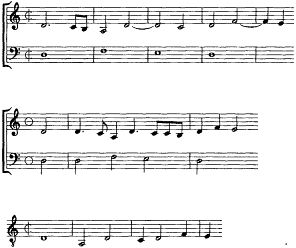
EXAMPLE 2B . (i) Faugues, Patrem, mm. 1-6; (ii) Le Rouge, Et in terra, min. 1-4; (iii) Barbingant, Et in terra, mm. 1-5

(continued )
EXAMPLE 2 (continued )
EXAMPLE 2C . (i) Faugues, Crucifixus, mm. 1-7; (ii) Le Rouge, Et in spiritum (SPB80), Et incarnatus (Tr90), mm. 1-3; (iii) Barbingant, Christe, mm. 1-7
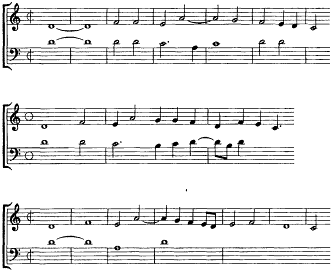
EXAMPLE 2D . (i) Faugues, Pleni, min. 1-5; (ii) Le Rouge, Pleni, mm. 1-3; (iii) Barbingant, Benedictus, mm. 1-7
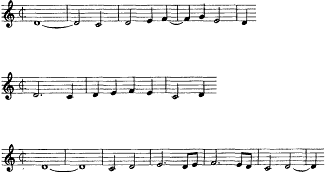
(continued )
EXAMPLE 2 (continued )
EXAMPLE 2E . (i) Faugues, Pleni, mm. 16-20; (ii) Le Rouge, Pleni, mm. 25-30

EXAMPLE 2F . (i) Faugues, Benedictus, mm. 1-9; (ii) Le Rouge, Benedictus, min. 1-4, 5-6
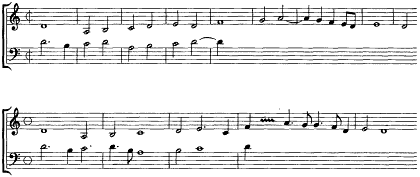
(continued )
EXAMPLE 2 (continued )
EXAMPLE 2G . (i) Faugues, Agnus II, mm. 1-4; (ii) Le Rouge, Agnus II, mm. 1-5; (iii) Barbingant, Agnus II, mm. 1-3; (iv) Puyllois, Missa , Agnus II, mm. 1-4
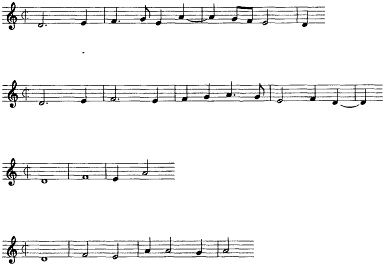
EXAMPLE 2H . (i) Faugues, Agnus I, min. 1-3; (ii) Barbingant, Agnus III, min. 1-4
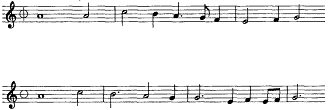
EXAMPLE 2I . (i) Faugues, Qui sedes, mm. 9-15; (ii) Le Rouge, Se je fayz dueil , part 2
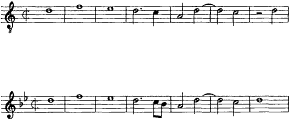
Barbingant and Puyllois, Le Rouge could not have been solely dependent on Faugues. There is also evidence that Faugues was not exclusively indebted to Le Rouge: While all of the motives that Faugues shares with Barbingant's Missa are also present in Le Rouge's Mass, Faugues is more likely than Le Rouge to have motives with the same text set by Barbingant.
A partial measure of the many similarities between the Puyllois Missa and the Masses by Barbingant and Le Rouge is shown in Example 3. The head motive in the Puyllois Mass does not remain constant. After the Kyrie I, which begins d-f-e-c and then winds its way up to a', Puyllois transforms the motive in various ways, either by preceding the four opening pitches with f (Ex. 3b) or d-f (Ex. 3c) or by following them with a descent to the lower a (Ex. 3e). In the Sanctus the motive that begins on d and then descends from f to a is varied from one section to the next. Most of the motivic permutations that occur in the Puyllois Missa also occur in the Barbingant Missa , in essentially the same sequence. But while Puyllois spreads his throughout each movement of the Mass, Barbingant concentrates them in the Kyrie, Sanctus, and Agnus (the other movements having stronger resemblances to the Le Rouge Mass).
All four Masses in this cluster relate motivically at the head motive of the Agnus II (Ex. 2g). Despite the commonplace character of this ubiquitous d-f-e-a' motive, the coincidence of variants on this motive at the same text, in four Masses with numerous other motivic ties, is less likely to be a matter of chance. Among all the many other instances of this motive in Masses, only in the fifth Naples Missa L'homme armé does it occur at the Agnus II, there transposed to begin on G.
Who followed whom? Faugues and Barbingant both seem to depend heavily on Le Rouge. Stylistically Faugues's Mass is certainly later than the Missa So ys emprentid . In terms of length it extends far beyond the dimensions of that by Le Rouge. The entire Kyrie I, Christe, and Kyrie II of the Missa So ys emprentid last for forty-six breves of tempus perfectum , as opposed to forty-six breves in tempus perfectum diminutum for just the Kyrie II in Faugues's Mass. Barbingant's Missa , equally linked to Le Rouge and Puyllois, is transmitted in the second layer of SPB80 and in Tr89, with repertoires closer in date to those of CS51 and Tr91, the sources of the Missa La basse danse . Of the
EXAMPLE 3. Motivic comparison of Puyllois, Missa , Barbingant, Missa , and Le Rouge, Missa So ys emprentid
EXAMPLE 3A . (i) Puyllois, Kyrie I, mm. 1-4; (ii) Barbingant, Kyrie I, mm. 1-5; (iii) Puyllois, Et in terra, mm. 1-5
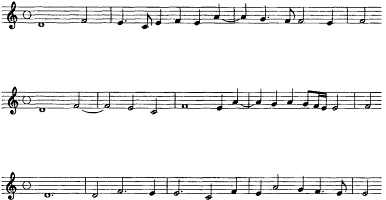
EXAMPLE 3B . (i) Puyllois, Qui sedes, mm. 10-15; (ii) Barbingant, Agnus I, mm. 1-4
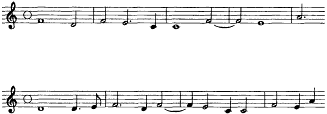
EXAMPLE 3C . (i) Puyllois, Patrem, mm. 1-4; (ii) Barbingant, Sanctus, mm. 1-5
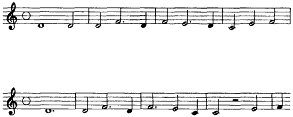
(continued )
EXAMPLE 3 (continued )
EXAMPLE 3D . (i) Puyllois, Domine Fill unigenite, min. 1-4; (ii) Le Rouge, Osanna I, ram. 1-4
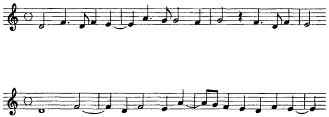
EXAMPLE 3E . (i) Puyllois, Sanctus, mm. 1-4; (ii) Le Rouge, Sanctus, mm. 1-3; (iii) Puyllois, Kyrie I, mm. 14-17; (iv) Barbingant, Pleni, mm. 11-13
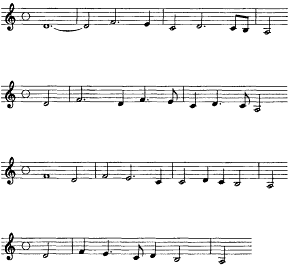
Masses by Le Rouge and Puyllois, that by Puyllois seems to be the older, but this is by no means certain. These four Masses therefore apparently fall into two chronological pairs, an early one of Puyllois and Le Rouge, and a slightly later one (perhaps fifteen years) of Faugues and Barbingant.
A previously unrecognized secular source of the Puyllois Missa sug-
gests an additional link to Le Rouge and Barbingant. Although Puyllois may have cited more than one chanson in his Missa , he draws extensively on Puisque je suis infortunée by Horlay, a composer closely associated with Puyllois in the chansonnier Escorial.[13] The chanson is particularly evident in the Sanctus. From the opening motive (Ex. 4a) through the mid-point of the chanson, each phrase is present in the Missa . Examples 4b and c show consecutive phrases of the chanson and Sanctus with cadential counterpoint that is at times identical. The me-dial cadence with its falling third in the superius then follows in the chanson (Ex. 4d). Both voices appear in the Qui tollis and at the end of the Qui ex patre, altered there to include a cadence on d rather than e. The bass melodic figure, marked "x," and the rhythms are identical. And the Qui tollis has a simplified version with both voices in duple meter.[14] In the Kyrie II there is a noncadential

Textually the Horlay chanson is close both in theme and rhyme to the chansons Terriblement suis fortunée and Pour une suis desconfortée . In each the poet blames his lack of fortune on the rejection of a lover, with rhyming verses on the word abandonée :
Puisque je suis infortunée, (line 1)
Et de m'amour abandonée ... (line 2)
Pour une suis desconfortée... (line 1)
Pour ce que suis abandonée ... (line 3)
Terriblement suis fortunée ... (line 1)
M'a de tous poins abandonée ... (line 6)
While Terriblement suis fortunée is well known as the source of a Mass by Barbingant, Pour une suis desconfortée is the preferred French text to Frye's English ballade So ys emprentid .[15] Thus Puyllois, Barbingant, and
[13] Martha K. Hanen, The Chansonnier El Escorial IV. a. 24 , I: 80-81, and below, p. 225 n. 35.
[14] On the strength of the sharped c in the chanson, a ficta alteration in the Mass is reasonable.
[15] On the sources and texting, see Leeman Perkins and Howard Garey, The Mellon Chansonnier , 2:370-72; and Isabel Pope and Masakata Kanazawa, The Musical Manuscript Montecassino 871 , 567-68.
EXAMPLE 4. Motivic comparison of Horlay, Puisqueje suis infortunée and Puyllois, Missa
EXAMPLE 4A . (i) Horlay, mm. 1-3; (ii) Puyllois, Sanctus, mm. 1-4

EXAMPLE 4B . (i) Horlay, mm. 8-10; (ii) Puyllois, Sanctus, mm. 12-17

EXAMPLE 4C . (i) Horlay, mm. 11-16; (ii) Puyllois, Sanctus, mm. 17-21
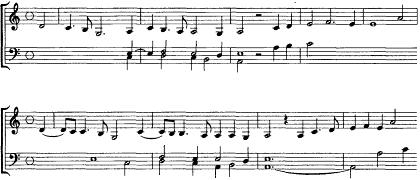
(continued )
EXAMPLE 4 (continued )
EXAMPLE 4D . (i) Horlay, ram. 14-19; (ii) Puyllois, Qui ex Patre, ram. 34-38; (iii) Puyllois, Qui tollis, mm. 37-47
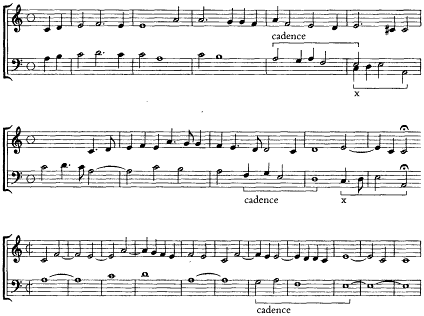
EXAMPLE 4E . (i) Horlay, mm. 25-28; (ii) Puyllois, Kyrie II, mm. 16-20

(continued )
EXAMPLE 4 (continued )
EXAMPLE 4F . (i) Horlay, mm. 1-3; (ii) Puyllois, Kyrie, mm. 1-4
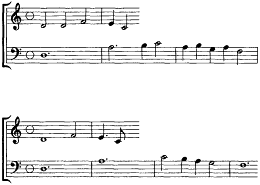
Le Rouge may each have written Masses based, at least in part, on chansons with a related message. That they probably did so within a few years of each other—on stylistic and paleographic grounds they have been dated circa 1450—increases the likelihood of some conscious emulation, an emulation also suggested by the other motivic ties between the Masses by Le Rouge and Puyllois and later by Barbingant and Faugues.[16]
From a purely musical standpoint, the motivic similarities between these four Masses demonstrate vividly that composers could emulate one another without reference to the tenor. While composing his Mass on a dance tune presented in the tenor, Faugues cited motives from
[16] Rob Wegman, "Petrus de Domarto's Missa Spiritus almus and the Early History of the Four-Voice Mass in the Fifteenth Century," 301, dates the Puyllois Missa ca. 1445 on the basis of its appearance in Tr87. However, Bent suggests that the Tr87 copy of this Mass was made from that in Tr93 on the basis of "errors shared between the two copies, and some deteriorations in the otherwise neater Tr 87 copy" ("Trent 93 and Trent 90," 90, n. 28). Saunders has dated the Tr93 copy at "1451, 1452" ("The Dating of Trent 93 and Trent 90," 73). That the Tr87 version could be later concurs with Gary R. Spilsted's hypothesis that the Tr87 fascicles that include the Mass, largely empty, were to "allow for further repertory to be added as it was needed" ("The Paleography and Musical Repertory of Codex Tridentinus 93," 56). He dated the watermark of this paper broadly at "ca . 1450 to ca . 1470" (75).
the Le Rouge Missa So ys emprentid in the contrapuntal voices, as did Barbingant. Without a doubt this kind of citation had textual meaning.
Caron and the Anonymous Missa, SPB80, Folios 122-29
An anonymous Mass in layer 1 of SPB80 has compelling ties to Masses by Caron. Initially the most striking similarity is the high degree of motivic correspondence. The head motive was a familiar one to Caron. Example 5 juxtaposes the head motive as it appears in the Kyrie and Agnus to statements in the Missa Clemens et benigna , the Missa Thomas (transposed), and what might be the beginning of the missing Agnus for the Missa Sanguis sanctorum ,[17] as well as in Masses of Ockeghem, Bedyngham, and Domarto and in Dunstable's motet Salve scema sanctitatis . In these as in other instances tallied in Table 17, the motive often occurs in one section of the Sanctus. Of all the motives shown in Example 5 and listed in this table, those by Caron consistently show the rhythmic pattern found in the Missa . Although it is not included here, the Pleni of the third Naples Missa L'homme armé is rhythmically close to the Missa Sanguis sanctorum fragment.
This motive doubtless relates to a widely popular motive of the same period, a motive with possible Marian associations that had a special appeal to Dunstable and other British composers and also to Du Fay (Table 18). Example 6 has a representative sampling, beginning with three appearances at Et in terra: this SPB80 Missa , Caron's Missa Sanguis sanctorum , and Du Fay's Missa Sancti Antonii Viennensis . The Patrem of Bedyngham's Missa Deuit angouisseux and a Benedictus by Sovesby provide precedents for the rhythm used by Du Fay and Caron. Among the many examples of this motive with a Marian text are two motets by Dunstable, his Sancta Maria, non est tibi similis and Sub tuam protectionera , and the anonymous Missa Regina coeli laetare in Tr91. Marian interpretations of the Song of Songs doubtless influenced the application of the motives in Tables 17 and 18 to the settings of
[17] This fragmentary superius line is in Ver755, fol. 42v, immediately after the conclusion of the Sanctus.
EXAMPLE 5. Comparison of Sanctus motive in Anonymous, Missa (SPB80, fols. 122-29) with occurrences in works by Caron, Ockeghem, Bedyngham, Domarto, and Dunstable
EXAMPLE 5A . (i) Missa , Kyrie I; (ii) Missa , Agnus I
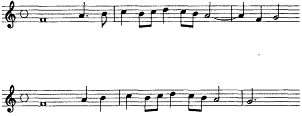
EXAMPLE 5B . (i) Caron, Missa Clemens , Benedictus (transposed from G); (ii) [Caron], Missa Thomas , Pleni (transposed from G); (iii) Caron, Missa Sanguis , Agnus I?
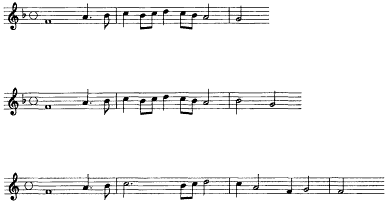
(continued )
Descendi in ortum meum, Quam pulchra es , and Quae est ista by Dun-stable, Hothby, and the anonymous composers. And in secular settings a Marian association presumably also lies behind Busnois's use of the motive at the beginning of his chanson Ja que line and as counterpoint midway through Je ne puis at the text "Noble femme."
EXAMPLE 5 (continued )
EXAMPLE 5C . (i) Ockeghem, Missa Mi mi , Pleni; (ii) Bedyngham, Missa (Tr88), Sanctus; (iii) Domarto, Missa, Et in terra; (iv) Dunstable, Salve scema sanctitatis
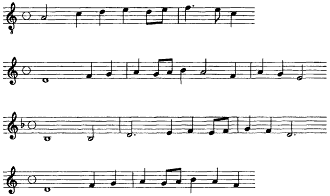
But in addition to some of the same fashionable motives in the SPB80 Missa and Masses of Caron, there are others less common. The Christe motive turns up in the Missa Accueilly , Osanna I (Ex. 7; other settings by Caron are shown in chapter 8, Ex. 31), a movement that also follows the same sequence of cadences as the Christe: a, c, and then f. Additionally, the Benedictus relates motivically to two Mass movements—the Missa Accueilly , Agnus I, and the third Naples Missa L'homme armé , Agnus II (Ex. 8)—and also to a Caron chanson, Pour regard doeul . The chanson connection, discussed in chapter 10 and shown there in Example 67, links not only the first motives but also an interior phrase of the Benedictus to part 2 of the chanson. Likewise, the Agnus II of the Missa is related to another Caron movement, the Missa L'homme armé , Agnus II, and another one of the Naples L'homme armé Masses, the Benedictus of the sixth Mass. This network of motivic relationships also includes both voices of the Ockeghem three-voice Missa , Agnus II.
Motivic resemblances to Caron extend to interior motives. The SPB80 Missa features a sequential pattern used by more than one
EXAMPLE 6. Comparison of Marian motive in Anonymous, Missa (SPB80, fols. 122-29) with occurrences in other fifteenth-century compositions
EXAMPLY . 6A . (i) Missa , Et in terra; (ii) Caron, Missa Sanguis , Et in terra; (iii) Du Fay, Missa Sancti Antonii , Et in terra (transposed from C)
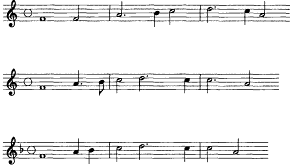
EXAMPLE 6B . (i) Bedyngham, Missa Deuil angouisseux , Patrem; (ii) Sovesby, Benedictus (Aosta, fols. 252v-53)

EXAMPLE . 6C . (i) Dunstable, Sub tuam protectionem ; (ii) Anonymous, Quam pulchra es (Tr90, fol. 342v); (iii) Busnois, Ja que li ne
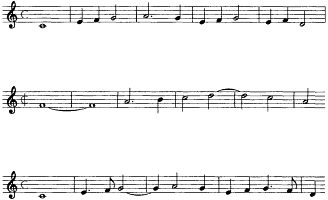
EXAMPLE 7. Motivic comparison of (a) Anonymous, Missa (SPB80, fols. 122-29), Christe; and (b) Caron, Missa Accueilly , Osanna I
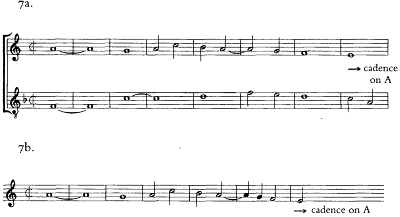
EXAMPLE 8. Motivic comparison of (a) Anonymous, Missa (SPB80, fols. 122-29), Benedictus; (b) Anonymous, Missa L'homme armé (Naples 3), Agnus II; and (c) Caron, Missa Accueilly , Agnus I
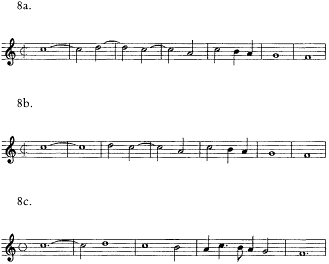
EXAMPLE 9. Comparison of counterpoint in (a) Caron, Missa L'homme armé , Crucifixus; and (b) Anonymous, Missa (SPB80, fols. 122-29), Agnus II
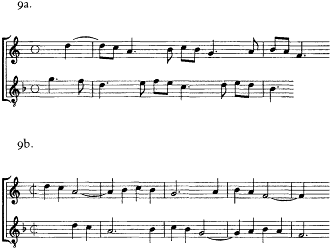
composer in the 1460s. In the Agnus II the imitative form of this sequence compares closely to the same descending line in the Crucifixus of Caron's Missa L'homme armé (Ex. 9).[18] It also appears, although not in imitation, in the Agnus II of the Ockeghem Missa just cited because of the resemblance between the opening gestures. Caron, as many of his generation, was also fond of F-major triadic figures such as those in the Patrem and Qui tollis of the Missa . This sort of trumpetlike fanfare could easily bring harmonic movement to a momentary stasis, as in the Missa , Patrem, and Caron's Corps contre corps (Ex. 10).[19]
Last, the conflicting signature present throughout the Mass,

[18] See also Philippe Caron, Missa Accueilly , Et resurrexit, mm. 8-9.
[19] There are similar passages in O vie fortunée and Cent mille escus . Caron's Madame qui tant est mon cuer also has an extended "C-major" triadic passage, min. 49-54.
EXAMPLE 10. Comparison of counterpoint in (a) Anonymous, Missa (SPB80, fols. 122-29), Patrem; and (b) Caron, Corps contre corps
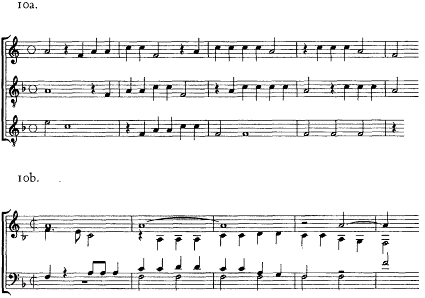
O vie fortunée, Pour regard doeul, Rose plaisant, Se doulx penser , and Vous n'avez point .
Despite all of these similarities, this is not likely a Mass by Caron but by someone who influenced him. There are too many important ways in which it departs from the conventions of Masses securely attributed to Caron. This Mass is not a tenor Mass but has a motto for the Kyrie, Sanctus, and Agnus, and there are no independent settings of either the second Osanna or the third Agnus, as there are in all known Caron Masses. Further, instead of duet beginnings, all movements begin with all voices, a difference that may be excused because we have no Masses for three voices attributed to Caron for comparison. Its mensural usage is, for the Kyrie, Gloria, and Credo, much like that of the Missa Sanguis sanctorum . The Sanctus, however, goes its own mensural way at the Osanna I by its use of Ø. All of Caron's Masses use either tempus perfectum or tempus imperfectum diminutum for the Osanna I
(see Table 23 on p. 398). Perhaps most of all, and difficult to demonstrate in a musical example or two, the rhythms are too straightforward to be from the hand of Caron, whose predilection for syncopated lines inspired the highly irregular bar lines that render the complete edition of his works so difficult to use.
Bedyngham or one of his compatriots warrants consideration. Of the attributes described above, Bedyngham also used static harmonies on F triads in his Tr88 Missa in the Confiteor (mm. 185-88), while in the compositions of John Plummet—for example his Anna mater matris —they are particularly common. And the same conflicting key signature occurs in several works of Power and Bedyngham, usually with the identical clef combination of the SPB80 Missa (C1, C3, C3), the same high ranges, and the same degree of voice crossing, as in Bedyng-ham's Missa Deuil angouisseux and his Benedicamus Domine (Tr88).[20]
The motives from the Missa listed in Tables 17 and 18 occur frequently in English works, as does the following motive, found throughout the SPB80 Missa (Ex. 11). In Stone's Tota pulchra es and in the Missa attributed in Strahov to the little-known British composer Standly, the motive fulfills a similar function as a kind of contrapuntal filler. In contrast, when Du Fay handled it, as in the canonic duet that appears in both the Ave regina coelorum and Ecce ancilla Masses, the contrapuntal texture is more complex. In later decades, as discussed in chapter 9, Martini turned to this motive reflexively. Last, if the Christe motive shown above in Example 7 is close to Caron, it is contrapuntally closer to Bedyngham (Ex. 12). Together with its tenor it appears as the second phrase of Bedyngham's Myn hertis lust , with texts that could not be more rhetorically appropriate for the Christe: "Which are the guide unto my perfect life" [Which is the guide unto my par-
[20] The fauxbourdon cadence in the SPB80 Missa , Et in spiritum, mm. 55-61, occurs virtually note for note in the anonymous Kyrie in Tr88 (fols. 26v-27), mm. 27-32 of the Christe (see the edition in Rebecca Gerber, "The Manuscript Trent, Castello del Buonconsiglio, 88: A Study of Fifteenth-Century Manuscript Transmission and Repertory, 2:3-7). This Kyrie appears to be related to the Missa angouisseux (though I agree with David Fallows that this Kyrie is not characteristic of Bedyngham's style ["Johannes Bedyngham," 348]). But because fauxbourdon cadences are so prescribed, the identity of three contrapuntal lines for six breves is less significant than it would be for other types of cadential counterpoint.
EXAMPLE 11. Motivic comparison of (a) Anonymous, Missa (SPB80, fols. 122-29), Patrem, mm. 12-15; and (b) Standly, Missa , Patrem, mm. 9-13
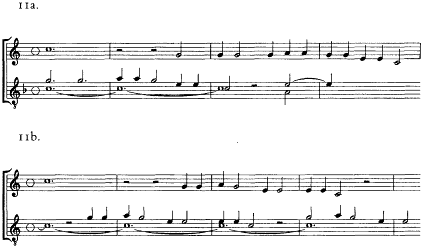
EXAMPLE 12. Bedyngham, Myn hertis lust , mm. 8-11

faite liffe] and "Whom I serve with attentive heart" [Whom that y serve with herte atentiffe].[21] As demonstrated shortly, when Caron sets this phrase he does so in a different harmonic and contrapuntal context.
The SPB80 Missa stands as a musical hybrid, the likely product of an English composer working on the Continent or a Continental composer with pronounced insular tendencies.
[21] The translation is by Howard Garey (Perkins and Garey, The Mellon Chansonnier , 2: 386).
Chapter Seven—
Faugues:
Attribution and Association
Missa Pour L'amour D'une
One of the anonymous Masses in SPB80 is almost certainly by Faugues, for reasons structural, mensural, melodic, and contrapuntal. The three-voiced Missa Pour l'amour d'une (fols. 154v-66), copied into the earliest layer, likely dates from the 1450s or the early 1460s. The lone concordance for this Mass is an Italian treatise on proportions that includes a portion of the Crucifixus.[1] The source of the cantus firmus does not survive, but as with all known Masses of Faugues it is a chanson, probably polyphonic. Adhering to another trademark of Faugues, the Missa Pour l'amour repeats the music from one Mass movement for another. In this case the music of the Kyrie II returns for the Osanna, a repetition Faugues also used in the Missa L'homme armé and the Missa La basse danse . Although the same type of duplication happens as well in the anonymous Missa Au chant de l'alouete in SPB80, in Obrecht's Masses on Adieu mes amours and Libenter gloriabor , and others, in none of these Masses can one also find so many other characteristics of Faugues.
Generally the mensural organization in a Mass by Faugues contains few complexities. Tinctoris he is not. The compilation of his mensural signs presented in Table 19 shows the limited range of his mensural successions and combinations at a glance. The Missa La basse danse is
[1] The treatise is preserved in Per1013, fols. 78-123. Most of the numerous examples are by Tinctoris. Aside from many anonymous examples, there are three by Du Fay, one by Busnois, and four by Faugues (not counting this Crucifixus). On the treatise see Bonnie Blackburn, "A Lost Guide to Tinctoris's Teachings Recovered," 31-45.
EXAMPLE 13. Missa Pour l'amour , Benedictus, min. 1-8

the most intricate, with the tenor often in tempus imperfectum prolatio maior while the other parts move in tempus perfectum diminutum . The simplest Mass in this regard and perhaps also one of the latest, the Missa Je suis en la mer , has only two signs used in alternation. Faugues curiously refrains from employing ternpus imperfectum and relies instead exclusively on tempus imperfectum diminutum . This last trait also exists in the anonymous Missa Pour l'amour , but with a telling deviation in the Benedictus.
Twice in the Missa Pour l'amour a proportional relationship between separate voices is indicated not with proportions but by combining unequal mensuration signs. In the Crucifixus duet beginning at "Et iterum," the superius moves in tempus perfectum against tempus imperfectum diminutum in the bass. Notationally this causes a semibreve in the bass to equal a minim in the superius (or, as in Exs. 13-17, a half note in one voice to equal a quarter in the other). In the Benedictus duet the proportional relationship becomes all-pervasive. By means of continually changing mensuration signs and proportions, the speed increases incrementally. Beginning in Example 13 with a proportio dupla —superius in tempus imperfectum diminutum and bass in tempus imperfectum —the duet eventually doubles the tempo to conclude in another proportio dupla. In between the music passes through other proportions: sesquitertia (4: 3) in measures 31-36, dupla again in measures 37-48, and sesquialtera (3:2) in measures 49-52, although the latter effectively disappears when the lower duple voice becomes triple with coloration. Expressed in terms of the numbers of semibreves, the ratios in this remarkable movement progress from 4:2 to 4:3, 6:3, 3:2, and 4:2 (2:1). It is fitting that in the central 6:3 proportio dupla there is a passage of strict imitation at the octave; thus one part follows the other at the Pythagorean interval 2:1.
Faugues achieves the same 2:1 proportional relationship in his La
basse danse and L'homme armé Masses when he writes simultaneously in tempus imperfectum prolatio mairo and in tempus perfectum diminutum . A semibreve under the former sign equals a breve under the latter. Indeed, Tinctoris specifically cites Faugues when he discusses this practice in the following passage of the Proportionale musices :
Others, indeed, place for the sign of the duple proportion only the sign of tempus imperfectum and minor prolation with a tail drawn through it, as that [sign] for the speeding up of the measure mentioned above, a method in which the melody is popularly called 'half time' [ad medium ].... This, as I am satisfied with De Domarto and Faugues in the Masses Spiritus almus and Vinus , so sung [with] this sign, I find tolerable because of a certain equivalence of the former proportion and the latter proportion; for when something is sung in 'half time', two notes are thus measured through the double proportion of one.[2]
Unfortunately, in the one extant source that preserves the Missa Vinnus vina , CS51, there is no such passage.[3] The operative word here is extant , because a scribe who did not approve of this usage, or who found it old fashioned, could easily have transformed the unequal voices into the same note values. Passages combining tempus imperfectum and tempus imperfectum diminutum could have existed in any of several spots in the Missa Vinnus vina . The lengthy maximae in cut-C that stretch out the cantus firmus in the Qui sedes and Et in spiritum would be longae in tempus perfectum . Or as in the Missa Pour l'amour , the Crucifixus has a phrase of strict imitation at "Et iterum venturus est," with a texture easily adaptable to one voice in tempus perfectum . Still closer to the proportional passages found in the Missa Pour l'amour , the Benedictus has not only the same text, but it is also for the most part a duet, the most extensive in the Mass.
Hypothetical as it may be to ponder what this or that portion of the
[2] I have slightly altered the translation of Albert Seay, "The 'Proportionale musices,' of Johannes Tinctoris," 41. The Latin version is in Johannes Tinctoris, Opera theoretica , ed. Albert Seay, 2a:45-46. On Faugues and the Missa Vinnus vina , see below, pp. 188-94.
[3] In his edition of Tinctoris, Proportionale musices (Tinctoris, Opera theoretica , 2a:46, n. 23), Seay wrongly reports that the Sanctus begins with a cut-circle in the superius and a circle in the other voices. He cites as his source not the manuscript but the incipit found in Llorens's catalogue, the Capellae Sixtinae codices musicis notis instructi sire manu scripti sire praelo excussi , 489, where the alleged, but erroneous, combination of mensuration signs appears.
EXAMPLE 14. Comparison of (a) Missa Pour l'amour , Benedictus, mm. 9-17; and (b) Faugues, Missa La basse danse , Benedictus, mm. 21-27
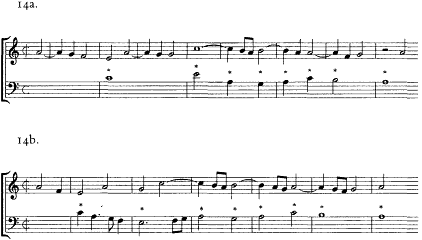
Missa Vinnus vina might have looked like before a mensural transformation, this speculation is not idle. Several phrases found in proportional notation in the Benedictus of the Missa Pour l'amour also exist virtually note for note in Faugues's Missa La basse danse , notated conventionally; even the rhythms are often the same. These segments appear side by side in Examples 14-17. The first instance (Ex. 14) involves a duet within the three-voice Benedictus of the Missa La basse danse (an asterisk marks the bass notes in common).[4] These two phrases include the first important cadence in the respective movements.
For the next two excerpts from the Missa La basse danse , Qui tollis, I have reduced three voices to two. The lower of the two voices in each example takes some notes from both the contra and bass voices. In Example 15 the contra supplies most of the lower voice, except for the last notes from the bass; in Example 16 the first three notes come from the contra, the rest from the bass. The superius parts are virtually identical. Both segments in Example 15 begin with a cadence on a, descend to a cadence an octave lower, and then move ahead. And
[4] A similar passage also exists in the revised Agnus II of the Missa L'homme armé (mm. 46-50).
EXAMPLE 15. Comparison of (a) Missa Pour l'amour , Benedictus, mm. 48-56; and (b) Faugues, Missa La basse danse , Qui sedes, mm. 20-29
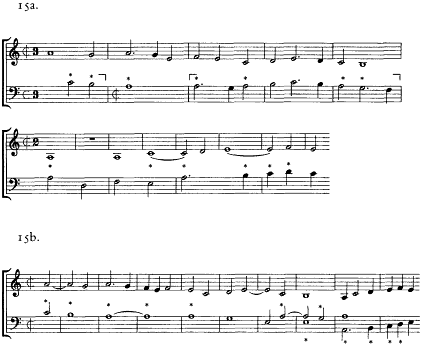
Example 16 shows the final, identical, phrases of each movement. Yet another segment of the Missa Pour l'amour Benedictus exists in the Agnus II trio of Faugues's Missa Le serviteur .[5] Together these examples account for almost half of the Benedictus, twenty-nine measures out of sixty-nine, including most of the free counterpoint unrelated to the cantus firmus. Finally, a proportionally notated phrase of the Crucifixus in the Missa Pour l'amour appears in the Missa La basse danse , both with the same text, "Et iterum" (Ex. 17).
The scope of these similarities provides additional evidence for naming Faugues as the composer of the Missa Pour l'amour . As contrapuntal passages they carry more weight than single-voice correspondences
[5] Missa Pour l'amour , Benedictus, mm. 25-30 corresponds to the Missa Le serviteur , Agnus II, mm. 21-26.
EXAMPLE 16. Comparison of (a) Missa Pour l'amour , Benedictus, mm. 65-69; and (b) Faugues, Missa La basse danse , Qui sedes, mm. 74-79
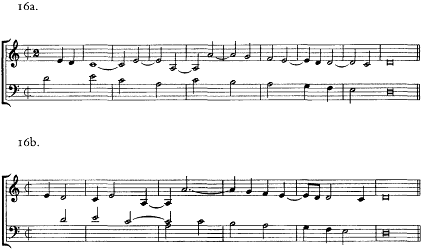
EXAMPLE . 17. Comparison of imitation in (a) Missa Pour l'amour , Crucifixus (Et iterum); and (b) Faugues, Missa La basse danse , Crucifixus (Et iterum)
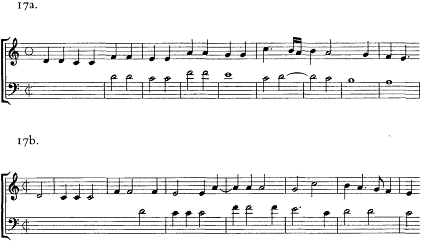
(though these exist as well). But aside from this, the discovery of passages notated once proportionately and once uniformly provides new examples of scribes exercising the freedom to renotate music with different mensuration signs. Given the extensive liberties that Nicholaus Ausquier took in SPB80 with the mensuration signs of the Du Fay motet and Missa Ave regina coelorum , this second point is of interest because the alterations could stem from the composer himself.
There are additional melodic similarities between the Missa Pour I' amour and the Missa La basse danse . The Crucifixus of the Pour l'amour and La basse danse Masses begin with the stock-in-trade d-f-e-a' motive. Among the approximately eighty instances of this motive that I am aware of from this period, these are the only two with the Crucifixus text. And the Et in terra of the La basse danse Mass combines two familiar motives, the so-called English 1-3-4-5 motive and a rising octave and descent known in several L'homme armé Masses as the second tune (Ex. 18). These motives also occur together in the Missa Pour l'amour at the start of the Confiteor. Both motives are commonplaces, but in combination they represent yet another link between Faugues's style and this anonymous work. As in the preceding examples, the slower note values in Example 18b do not indicate a slower tempo, only the diminished mensuration sign.
The second of these motives also figures contrapuntally in both the Pour l'amour and La basse danse Masses. In the anonymous Mass this motive opens the Qui sedes imitatively, while in the phrase from Faugues's Et in terra (also seen in Ex. 18) the contra parallels in thirds. What distinguishes each of these movement-opening passages, however, is not the counterpoint but the way in which an abbreviated version of the motive also crops up at the very end of the preceding section, also in imitation. As if in preparation for the next movement beginnings, these concluding motives commence immediately after the penultimate cadences of their respective movements, thirteen imperfect breves from the end of the Qui tollis in the Missa Pour l'amour , and just four perfect breves from the end of the Kyrie II in the Missa La basse danse .
Another motive turns up in almost every movement of these two Masses. The figure usually appears at cadences in tempus perfectum , most often in some form of a triplet rhythm, either dotted, trochaic (long-short), or iambic (short-long). Example 19 has two from each Mass.
EXAMPLE 18. Motivic comparison of (a) Missa Pour l'amour , Confiteor, ram. 1-6; and (b) Faugues, Missa La basse danse , Et in terra, min. 1-12

EXAMPLE 19. Comparison of cadential patterns in (a) Missa Pour l'amour , Kyrie I, mm. 6-9; (b) Faugues, Missa La basse danse , Sanctus, mm. 20-23; (c) Missa Pour l'amour , Et in terra, mm. 7-10; and (d) Faugues, Missa La basse danse , Cum Sancto, min. 34-37
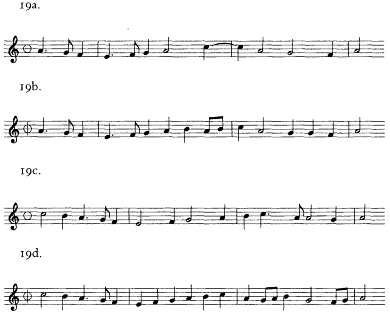
EXAMPLE 20. Comparison of formulaic motives in (a) Missa Pour l'amour , Agnus I, ram. 18-23; and (b) Faugues, Missa Le serviteur , Benedictus, mm. 38-44

While these fit easily enough in a triple meter, Faugues also maintained the motive in this form during movements in tempus imperfectum .
Further contrapuntal and mensural correspondences exist with Faugues's Missa Le serviteur . The motivic techniques shown in Example 20 testify to the formulaic nature of much of Faugues's imitative writing. The three phrases labeled A, B, and C occur in each Mass successively, but in different orders. All three occur often among composers of Busnois's generation. Yet the way in which they appear, not just patched together one after another but also in strict imitation at a distance of one breve (both perfect and imperfect), suggests a composer relying on flexible and familiar improvisational patterns.[6] Supplementing these motivic considerations, the sectional lengths and mensuration signs of individual movements of the Missa Pour l'amour share characteristics
[6] Among several other contrapuntal similarities, a motive related to phrase b of Ex. 20 occurs in both Masses at a variety of imitation intervals: two perfect breves (Missa Pour l'amour , Qui tollis, mm. 41-47), two imperfect breves (Missa Le serviteur , Benedictus, mm. 17-21), one-and-a-half imperfect breves (Missa Pour l'amour , Patrem, mm. 6-9), and one perfect breve (Missa Le serviteur , Christe, mm. 70-76). In each Mass the cadential formula in the bottom voice happens both at the lower octave and at the upper. A loosely imitative passage in the Patrem (mm. 25-30) of the Missa Pour l'amour runs the same course as a passage in the original Agnus II of the Missa L'homme armé (mm. 9-12).
with Faugues's Missa Je suis en la mer . For three of the Mass movements—Kyrie, Sanctus, and Agnus—the lengths of sections are quite close, at times even exact. As shown in Table 20, where these movements are compared, the three opening sections correspond exactly, and the mensuration signs differ only for the Osanna.
The pervasive motivic similarities, together with the characteristic repetition of music between Mass movements and the Faugues-like mensural practices (especially the use of unequal mensuration signs to specify proportions), constitute grounds for attributing the Missa Pour l'amour to Faugues. Aside from increasing the number of Masses by Faugues to six—together with the Missa Vinnus vina —rather than the four published in his "complete works," the attribution of a Mass in SPB80 to Faugues adds another Italian manuscript to the other uniformly Italian sources of his works. The Missa Pour l'amour is not necessarily earlier than the Missa Le serviteur or the Missa La basse danse . All are quite compatible with a dating of circa 1455-65 and the mensuration signs differ only for the Osanna.
Missa, Spb80, Folios 129v-43
A second anonymous Mass in SPB80 has many of the same Fauguesian traits. But despite its use of structural repetition, its contrapuntal and motivic correspondences with other Masses by Faugues, and its similar mensural and rhythmic organization, the three-voice Mass on folios 129v-43 cannot be attributed to Faugues; rather, it is to Faugues what the Missa on folios 122-29 is to Caron: the product of a close contemporary. Although the cantus firmus is unknown, consistent with Masses by Faugues, it appears to be a chanson tenor (see Ex. 21). The melodic emphasis on the c in upper and lower octaves, the contralike leaps in measures 11-13, and the triadic leaps in measures 19-20 suggest a chanson from before 1450; further, the descents down a tenth to c and the triadic, bass-voice pattern in measures 27-28 are both characteristic of the Le serviteur tenor.
In this Mass every movement has at least one section in common with some other movement. As in Faugues's Le serviteur, La Basse danse , and Je suis en la mer Masses, not one but two sections repeat: The Kyrie II returns as the Osanna, and the Cum sancto comes back twice, as the Agnus III and also as the end of the Credo (see Table 21). In
EXAMPLE 21. Tenor of Missa (SPB80, fols. 129v-43), Agnus I
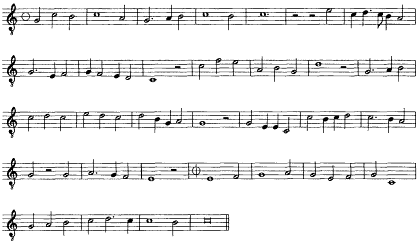
addition, six measures of the Christe (mm. 23-30) return in the Crucifixus (mm. 28-34), and the brief triple-meter (cut-circle) passage at the end of the Et in terra also closes the Agnus I. Thus the Kyrie and Sanctus conclude with the same music, and the beginning and end of the Agnus take from the beginning and end of the Gloria. Remarkably, since the Credo also ends as the Gloria had, every movement shares its last measures with another. With regard to the conclusion of the Gloria and Credo in the Missa , the lengths and texts of the repeated section are the same as those in the Missa Le serviteur . Starting at the text "Cure Sancto spiritu" in the Gloria, the final section requires thirty-six-and-a-half breves to finish in the Missa Le serviteur and thirty-seven in the three-voice Missa . The identical music then returns in both Credos with the words "Et expecto resurrectionem ... Amen"; however, in the Missa the first seven measures are split from the rest, appearing several measures earlier at "Et unam sancram."
Similarities between this Missa and the Missa Le serviteur extend to motive and counterpoint. In some cases the intervallic patterns matter less than how the patterns are organized. For example, the opening measures of both Masses commence with a descent from g to c in the superius (Ex. 22). The motives are not unusual (and the modal context
EXAMPLE 22. Motivic comparison of (a) Missa (SPB80, fols. 129v-43), Kyrie I, mm. 1-3, 6-10; and (b) Faugues, Missa Le serviteur , Kyrie I, mm. 1-3, 7-11
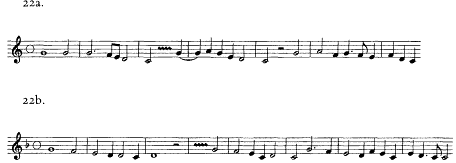
is quite different). But by virtue of being heard three times in the first ten or eleven measures, the motive becomes contextually distinctive. The similarity is aurally enhanced by a deceptive cadence in each.[7]
The Et in terra sections of these two Masses also adhere to similar structural plans. Beginning with duets, the contras present the start of the tenor cantus firmus, condensing eight or nine measures from the Kyrie I into five or six, respectively. When the tenors enter at "Gratias agimus," the bass, tenor, and superius voices are clearly related (see Ex. 23, in which the contra is omitted from the Missa Le serviteur ). Variants of the superius motive subsequently return at "Quoniam tu solus Sanctus." Likewise the duets at the beginning of each Patrem correspond, with the contra presenting tenor material for the first ten measures. And the Gloria, Credo, and Sanctus each have a phrase that Faugues used a step higher in the Agnus II of the Missa L'homme armé (Ex. 24).
The mensural organization of this Missa has many features in common with the Missa Vinnus vina . The various sections of the Kyrie and Sanctus movements use identical mensuration signs, the two Agnus conclude in proportio tripla, and the Credos divide internally at the Crucifixus and the Et in spiritum with the same signs. It was Faugues's
[7] Missa , Kyrie I, m. 8; Missa Le serviteur , Kyrie I, m. 7.
EXAMPLE 23. Motivic comparison of (a) Missa (SPB80, fols. 129v-43), Et in terra, mm. 15-18; and (b) Faugues, Missa Le serviteur , Et in terra, ram. 25-29
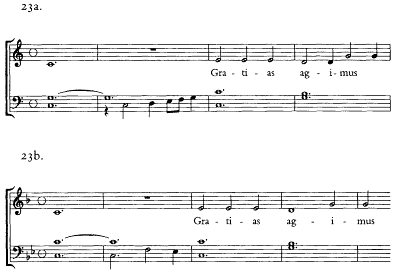
normal practice to divide the Credo first at the Crucifixus, but later divisions follow no single pattern. Four break at Et in spiritum, and four at Confiteor. In the Sanctus the Missa Pour l'amour is the only Mass to delay the arrival of tempus imperfectum diminutum until the Benedictus.
Even with these extensive structural correspondences, the Missa has too many features not found in Masses by Faugues. Phrase structure tends too often toward the short and disjunct, in the manner of Barbingant. The greater sectionalization stems from simultaneous rests and, in duple meter, phrase-ending fermatas, a chanson device that Faugues is not known to have used. In one especially choppy portion of the Crucifixus, there are three fermatas within the space of forty-six breves, two of them followed by a breve of simultaneous rest. Rhythmically the portions of the Missa in tempus imperfectum diminutum stick to square patterns that are far less syncopated than normal for Faugues. In its use of motives, aside from those resemblances noted above, the
EXAMPLE 24. Comparison of cadential phrase in (a) Missa (SPB80, fols. 129v-43), Cum Sancto, mm. 29-35; and (b) Faugues, Missa L'homme armé , Agnus II, mm. 60-67
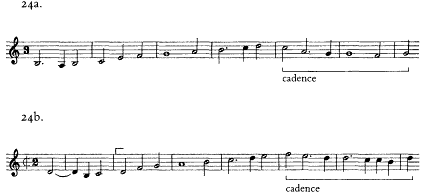
extensive similarities to Faugues's counterpoint seen in the Missa Pour l'amour are lacking. Finally, and less obviously, although the Missa has roughly the same amount of imitation as the Missa Je suis en la mer or the Missa La basse danse , imitation in Faugues's Masses usually occurs at a time interval of two to four semibreves, whereas the most frequent distance in the Missa is a single semibreve or less.
For all of these reasons the anonymous Missa is probably not by Faugues but by someone working closely enough to him—a teacher, student, or colleague—to appropriate several structural (and a few motivic) details, particularly from the Missa Le serviteur . Of these the most characteristic of Faugues is the repetition of extended sections of music. Entire submovements such as the Kyrie II repeat, almost invariably, as the Osanna. Since Faugues also routinely repeats the Osanna (in contrast to Caron), the music of the Osanna is heard three times; for example, as Kyrie II, Osanna I, and Osanna II. The extreme case is the CS14 version of the Missa L'homme armé , in which the Kyrie II returns as the Cum sancto, the Confiteor, and the Osanna (and also the Agnus III?), in other words as the conclusion of each movement of the Mass Ordinary.
Whatever the reason for these repetitions, we cannot infer from
them that Faugues lacked invention. He was as capable of varying contrapuntal lines over repeated statements of a cantus firmus as Ockeghem. A rhetorical significance is possible, even probable, although his repetition schemes seem unrelated to textual ideas. Were this so, there would be more instances of Kyrie sections returning in the Agnus. Nor was Faugues the only composer to repeat movements. As listed in Table 21 there are at least nineteen instances during the fifteenth century, including Masses by Du Fay, Josquin, and Obrecht.
Three of the Masses in Table 21 involve a varied repetition of the Agnus I as the Agnus III. In the so-called Missa de Angelis by Binchois, Louis Gottlieb interpreted the double mensuration sign at the beginning of the Agnus I to call for a double-time rendition of the Agnus III, as occurs in the Touront Missa Monyel .[8] This usage of two mensuration signs also happens in the SPB80 Missa by Petrus de Domarto. There the Agnus I has the sign for tempus perfectum copied directly on top of that for tempus perfectum diminutum . After the Agnus II Ausquier copied the familiar directive "tertium Agnus ut supra." While tempus perfectum diminutum was probably not fully twice as fast as O, a faster tempo for the repetition is clearly indicated.
SPB80 has a significant concentration of Masses with structural repetition. When the instances of Agnus repetition are eliminated (because the texts are so close and Agnus I repetitions so common), and the canonic Trent Missa (because it is so brief), and also the Masses by Josquin, Obrecht, Pipelare, Vaqueras, and the anonymous BolQ16 Missa L'homme armé (because they are all later), what remains from circa 1455-75 are the Du Fay Missa Ecce ancilla , the Regis Missa L'homme armé , the five Masses by Faugues (including the Missa Pour l'amour ), and the three that survive only in SPB80: the Missa Pour l'amour , the anonymous Missa with stylistic ties to Faugues, and the Missa Au chant de l'alouete (attributed to Martini in chapter 9). Faugues and musicians at St. Peter's had an inordinate interest in Masses with structural repetition. If Faugues worked in Rome—as I will now argue—Rome looms as the major source of such Masses. Vaqueras and possibly also Josquin would thus be later representatives of a localized tradition.
[8] Louis Gottlieb, "The Cyclic Masses of Trent Codex 89," 1:74-75. Laurence Feininger published the Binchois Missa under this title in DPLSER, I.
Faugues at St. Peter's?
Despite a generation of archival sleuthing, the only solid biographical information about Faugues concerns a short stay in the Sainte-Chapelle at Bourges. There Faugues served briefly as master of the choirboys in the summer and fall of 1462. Documents discovered by Paula Higgins place Faugues in Bourges for indeterminate portions of two three-month quarters: first during the term of St. John the Baptist, beginning on 1 July, and again during the term of St. Michael, commencing on 1 October.[9] His salary for the fall term was small (just 37 sous , 4 deniers ), indicating that he left shortly after it had begun; and his pay for the summer term (9 livres , 6 sous , 6 deniers ) while larger, is still smaller than that given to six other singers, perhaps indicating that he had arrived shortly after that term had begun. Added together his wages amount to slightly more than 11 livres , or virtually the same as the top wage four of his colleagues made in a normal three-month period. He may therefore have served for three months that did not coincide exactly with the standard terms of pay. Several years later the chapter of the Sainte-Chapelle attempted to rehire him, evidently without success, to replace Dns. Johannes Ploton, who had died recently. On 16 July 1471 the chapter agreed to contact Faugues "presbiter" to see if he would return.[10]
Aside from these meager references, our knowledge of him comes from the distribution of his compositions, from contemporaneous citations by theorists, and from mention of him among the fourteen musicians named in Compère's motet Omnium bonorum plena . The earliest of the written accounts is Compère's motet, variously dated between 1468 and 1474.[11] Tinctoris is the first theorist to mention Faugues and probably also the source of the later theoretical references. In his Proportionale (1472-73) and Liber de arte contrapuncti (1477), written in Naples, Tinctoris both compliments Faugues and chastises him for
[9] Paula Higgins, "Tracing the Careers of Late Medieval Composers: The Case of Philippe Basiron of Bourges," 12-14; and idem, "Antoine Busnois and Musical Culture in Late Fifteenth-Century France and Burgundy," 257-58.
[10] Higgins, "Tracing the Careers of Late Medieval Composers," 26; and idem, "Antoine Busnois and Musical Culture," 258.
[11] David Fallows, Dufay , 77-78; and Charles Hamm, "The Manuscript San Pietro B 80," 48-49.
mixing proportional signs and for contrapuntal slips. His praise is effusive, his blame temperate. In the foreword to the counterpoint treatise, Tinctoris places Faugues in select company with Ockeghem, Regis, Busnois, and Caron, as followers of Dunstable, Binchois, and Du Fay, and so as one of the composers who "exhale such sweetness that in my opinion they are to be considered most suitable, not only for men and heroes, but for the immortal gods."[12] Even his criticism of Faugues's occasional diminished fifths is couched as praise: such mi contra fa errors are found "in the works of numerous composers, including the most distinguished , ..." and then he provides examples from Faugues, Busnois, and Caron.[13]
Faugues is also the composer of the anonymous Missa Vinnus vina preserved in CS51.[14] A surprising and biographically significant indication of Faugues's involvement with this Mass exists in the manuscript itself. The least reliable paleographic evidence is the point most often cited, that in CS51 the Missa Vinnus vina follows Faugues's Missa La basse danse . Indeed the Vinnus vina begins on the verso side of the folio that concludes the La basse danse Agnus III. But since the other composers represented by more than one Mass in CS14 and 51 usually do not have their Masses copied contiguously—Du Fay (with four Masses), Caron (three), and Regis (two) do not, Martini (two) does. it is questionable how much this really means.
Scribal hands reveal more than composition order. The copies of the Vinnus vina and L'Homme armé Masses by Faugues in CS14 and 51 have an extraordinary number of corrections in the manuscripts, apparently written by the same hand. Although most works in these sources have corrections, these two Masses by Faugues have many more than found in Masses by other composers. Exceeding all changes in CS14 in length and compositional effort is the revised Agnus II of the L'homme armé Mass (Figure 10). The later scribe was particularly zeal-
[12] Tinctoris, Liber de arte contrapuncti , 2:6, quoted from Oliver Strunk, ed., Source Readings in Music History from Classical Antiquity through the Romantic Era , 199.
[13] My emphasis. Tinctoris, Liber de arte contrapuncti , 2:155-56. The translation, by Gustave Reese and T. McNally, is from George C. Schuetze, An Introduction to Faugues , 3-4.
[14] Rob Wegman has conclusively shown the Missa Vinnus vina to be by Faugues in "Guillaume Faugues and the Anonymous Masses Au chant de l'alouete and Vinnus vina ," 27-64.
ous. He rewrote the entire contra part and, not previously detected, also added to the superius three or four notes that together comprise a single breve. Example 25a is the first half of the Agnus II as the original copyist wrote it; the measure to which the correcting scribe added notes is numbered 11-12. A comparison of the revised version in Example 25b shows that few measures of the contra part went unchanged. It is substantially this second version later copied into ModD, Ver761, and SMM JJ.III.4.
Since nothing was contrapuntally "wrong" with the old contra part, or for that matter even slightly awkward, the impulse to rewrite is significant—all the more so given the Faugues-like nature of the revisions. Strict imitation plays a much greater role in the later version, as one can see from the imitative passages marked with brackets in Example 25. At the center of the new Agnus the scribe inserted a two-voice canon that stretches over fifteen breves (mm. 21-35). Leaving the old superius part intact, he replaced nonimitative (or loosely imitative) counterpoint in the contra with a strict imitation of the upper voice at an interval of three breves. The counterpoint is completely characteristic of the extended imitations found in many duets by Faugues. One has the impression that the canonic passage, more than the missing measure, motivated the revisions and that, while he was at it, the musician decided to revise the whole part. Some of the other alterations are as remarkable for their insignificance as is this brief canon for its post facto conception and realization. Why, for instance, bother with removing the contra a and b in the middle of measure 10?[15]
The new part for the Agnus may be more dramatic than any single correction in the Missa Vinnus vina , but this Mass received equal care. There is hardly a folio without at least one emendation. Usually the revisions are only a matter of erasing a stem to change a minim into a semibreve, erasing an extraneous note, or changing a note. At the most
[15] This question applies to the contrapuntal differences between the "Rome" version of his Missa L'homme armé and that from Ferrara, which extend beyond the new Osanna, the shorter Sanctus and Credo, and the other large-scale changes. The ModD version has the same type of picayune contrapuntal revisions seen in the Agnus II. Many passing tones have been removed, and in the Pleni the cantus has four modified measures. Moreover, the removal of ornamental neighboring tones observed in m. 10 of the revised Agnus also happens in the Pleni in mm. 13-14 of the cantus, and in the Crucifixus, mm. 56-57.
EXAMPLE 25. Comparison of two versions of Faugues, Missa L'homme armé , Agnus II:. (a) original version in CS14, fols. 148v-49; and (b) corrected version
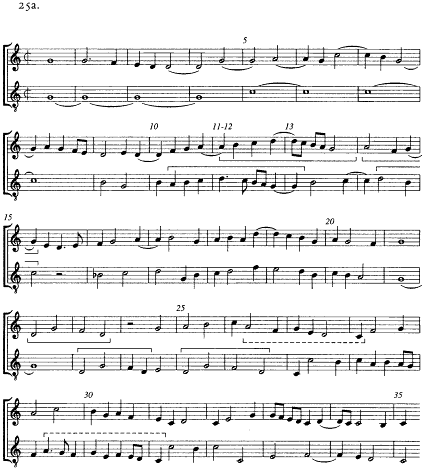
(continued )
the secondary scribe changed or added a few notes and ledger lines, as in Figure 11 (end of line 1 and middle of line 2, fol. 79v), or a clef (fols. 80v, 81). In all, they add up to forty-seven corrections, three times as many as the next most-corrected Mass in CS51, Gaspar van Weerbecke's Missa O Venus bant . I have tabulated the corrections made
EXAMPLE 25. (continued )
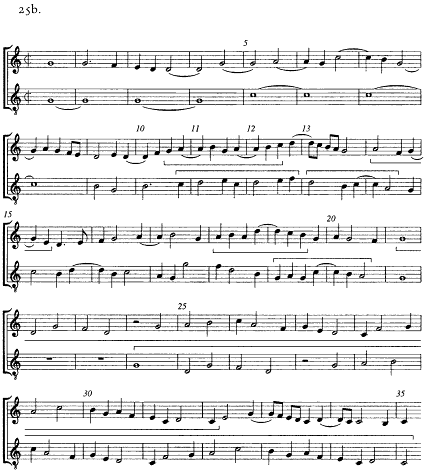
to Masses in this manuscript in Table 22. My count does not distinguish between the number of notes changed, so that what comprises a single correction varies anywhere from an erased stem to several added notes. A separate column accounts for notes actually added or changed by someone other than the main scribe, since it is not possible to determine who erased a note, the main scribe or some later hand. In this column the special attention accorded the Missa Vinnus vina stands out even more noticeably.
Comparatively few of the alterations can actually be called corrections. The scribe changed the clefs when necessary in the middle of a line (fol. 80), supplied several missing notes at the beginning of the Agnus, and shifted a c up a step to avoid a dissonance (fol. 75, line 2). He may also have been the scribe that erased a few notes inadvertently copied both at the end of one line and the beginning of the next (fol. 79, line 1). But if this sort of change were in the majority, one could attribute the disproportionately large number of alterations found in this Mass to a particularly bad exemplar used by the principal scribe. However, the scribe made too many changes for aesthetic reasons for this to be the case. Several times he eliminated a semiminim or fusa passing tone (Patrem, m. 53; Pleni, m. 18; Benedictus, m. 25). Once he smoothed the line by removing an échapée figure (Benedictus, m. 77), a change also found in the revised L'homme armé Agnus II. One alteration improved the imitation (Agnus II, m. 64), another obscured it, evidently in order to strengthen a cadence (Patrem, m. 24).
Not only are the corrections to both Masses substantially in the nature of compositional refinements, they appear to be the work of the same individual. A comparison of scribal hands reveals extensive similarities (Figure 12): notes—semibreves and minims are usually triangular and tear-shaped rather than diamonds, and the top line of breves often sinks down to the right (fol. 69, end of line 3); clefs—as with the breves, the C clefs both tilt down to the right, and the lower rectangle extends beyond the upper; ligatures—the right side of COP ligatures is prone to sag (fol. 70, line 8); and custos—the scribe dips down just before beginning the tail without thickening the pen stroke, and the tail itself curves (compare the custos at the end of line 1 in Figure 11 with those in Figure 10).[16] Whoever took it upon himself to correct these two Masses was interested in them exclusively. His hand does not appear elsewhere in the manuscripts. Other hands made additions to other works.[17]
[16] There is not enough text to make any but the most basic comparisons. The only words this scribe added to the Missa Vinnus vina , "verte cibo" (fol. 80, end of line 5), are in a French bâtarde script, as is the text of the new Agnus.
[17] See, for example, the corrections in the Missa Dixerunt discipuli of Eloy d'Amerval (CS14, fols. 57, 57v, and 63).
The second scribe in the Masses by Faugues probably made his revisions in Rome after the manuscript had been completed.[18] These numerous corrections have a parallel in the careful attention shown the works of Gaspar van Weerbecke in CS14 and 51. Other than the Masses by Faugues, the works most heavily corrected are the Du Fay Missa Ecce ancilla Domini in CS14 with seventeen corrections, the Missa O Venus bant by Gaspar in CS51 with sixteen, and Gaspar's Missa Ave regina coelorum in CS14 with fourteen. In the Roman source from the 1480s, CS35, the most-corrected composition is also by Gaspar, his Missa Princesses d'amourettes with thirteen changes. They also appear to be the work of one particularly interested scribe. Not surprisingly, as a longtime member of the papal chapel, Gaspar was well poised to do his own proofreading. Finally, as described in chapter 4, the alterations to create a pause before the Et incarnatus section in the Caron Missa Accueilly m'a la belle (CS51) and the Vincenet Missa Aeterne rex were certainly made in the Sistine Chapel.
To bring this discussion back to Faugues, two points. First, the changes in the Missa Vinnus vina are only partially to correct errors. And second, while those changes that are of a more compositional nature could well have been the work of an interested scribe, the appearance of what appears to be the same hand making some of the same contrapuntal refinements in the Faugues Missa L'homme armé suggests the particular involvement of the composer. Who other than Faugues would take such a proprietary interest in the Masses of Faugues? In this consideration the minor contrapuntal adjustments are no less important than the more sophisticated incorporation of the Faugues-like canonic passage in the Agnus II. Second, these changes, together with other compositional changes in the manuscripts, are most likely to have occurred in Rome. Given the liberties he took with manuscripts
[18] Adalbert Roth, Studien zum frühen Repertoire der päpstlichen Kapelle unter dem Pontifikat Sixtus IV. (1471-1484): Die Chorbücher 14 und 51 des Fondo Capella Sistina der Biblioteca Apostolica Vaticana , argues that these codices were copied in Naples and brought to Rome by 1475. Flynn Warmington, "The Winds of Fortune: A New View of the Provenance and Date of Cappella Sistina Manuscripts 14 and 51," persuasively rejects Roth's view, proposing instead Florence, ca. 1482. More recently, she has focused on the Veneto, based on the discovery of other manuscripts likely decorated by the same illuminator (private communication).
of the papal chapel, Faugues may have worked with these copies of his Masses as a member of that chapel.
Guillelmus Da Francia, Guillaume Des Mares, and Faugues
My intent is to identify Guillaume Faugues with the St. Peter's composer and scribe Guillelmus and also with Guillaume des Mares, a singer both at St. Peter's and the Sistine Chapel. I will discuss both of these figures separately before identifying the reasons for conflating their individual biographies with what we know of Faugues.
Guillaume des Mares, a tenor at St. Peter's from the latter half of July 1471 through June 1472, was a musician and cleric whose achievements have yet to be recognized. Elsewhere he is identified as a priest, master of choirboys, scribe, and author of a theological treatise. From St. Peter's he passed directly into the papal choir in July 1472, remaining until circa 1477-78. Benefices he sought as a member of the Sistine Chapel indicate origins in Normandy, with particular reference to a canonry at Evreux Cathedral and an unspecified benefice in the diocese of Lisieux,[19] and the parish church of Ste. Colombe near Caudebec in the diocese of Rouen. The last document names him as a priest from the diocese of Evreux.[20]
During the mid-1460s Guillaume traveled between Evreux and Chartres. Des Mares was in Evreux long enough to welcome the newly elected bishop Guillaume de Floques to the cathedral on 16 March 1464. Already a canon, he presented the bishop with a small tract (opusculum ) that he had written on the Holy Eucharist, with a dedication to Bishop de Floques.[21] Despite his gift, or perhaps because of it, des Mares soon left Evreux to become an instructor of children at
[19] Both are mentioned m Reg. vat. 569, fols. 20-21 (12 NOV. 1474). I am grateful to Jeremy Noble for this information. At St. Peter's he replaced, and was later replaced by, Johannes Guillant (also Guillault, Giglior, Quilant, Glant, and Olant).
[20] Reg. vat. 573, fols. 50v-51v (10 Feb. 1475).
[21] "Guillelmus de Mara canonicus Ebroicensis, dicavit Guillelmo [de Floques] opusculum de sacrosancta Eucharista" (Gallia Christiana , 11:605). See also Pierre Le Brasseur, Histoire civile et ecclésiastique de Comte d'Evreux , 289; and G. Bonnenfant, Histoire générale du Diocese d'Evreux , 1:94. All of these describe the lengthy battle Guillaume de Floques waged to take possession of his bishopric, only to die on 25 Nov. 1464.
the cathedral in nearby Chartres, confirmed there on 25 June 1464 for an undetermined period.[22] War broke out again in Normandy through much of 1471-72, just as des Mares was hired at St. Peter's. The Burgundian army at one point invaded and pillaged the territories of Caux, fighting as far as the city walls of Caudebec, where, as local histories take pride in telling, it was repulsed.[23] By July 1471 des Mares was singing tenor at St. Peter's, where he remained until he joined the papal chapel choir a year later. The Vatican account books cease in May 1476, when des Mares was still present, and resume in 1479, after he had left.
He apparently had relatives in Caudebec, all of them local officials and agents of the royal bureaucracy. Pierre des Mares, Adam des Mares, and also a Guillaume des Mares appear frequently and steadily in archival records from Normandy between 1448 and 1506, identified by such titles as "tabellion juré pour le Roy en siège de Caudebec" (1460), "procureur du Roy" (1466), "lieutenant du Verdier" (1480-81), "avocat et conseiller du Roy et vicontes de Caudebec et Monstiervillier," and also as minor nobility with the rank of écuier . However, the Guillaume who sang at St. Peter's and in the papal chapel is not the same as Guillaume des Mares, the écuier and avocat du roy active in Caudebec between 1463 and 1506.[24] This is indicated by a notice that the latter collected taxes in Caudebec for the year 1474-75, at a time when the singer was present in Rome.[25]
The earliest probable reference to Guillaume des Mares, the priest
[22] André Pirro cited this position in "Gilles Mureau, chanoine de Chartres," 164.
[23] R. de Maulde, Une vieille ville normande Caudebec en Caux , 43.
[24] Several references occur in Gustave Dupont-Ferrier, Gallia regia ou état des officiers royaux des bailliages et des sénéchaussées de 1328 à 1515, 2:22-23, 30-31.
[25] It is surely this other Guillaume that represented Caudebec at a convocation of the Norman estates in Caen on 1 Oct. 1470. Called by Louis XI, this assembly dealt with a question of the annual subsidy paid by the provincial estates to the royal treasury. In response to a commission that had met in Dec. 1469 about this issue, Norman representatives fought a perceived infringement of their rights, declaring that "the instructions of this commission were contrary to the laws, customs ... franchises and liberties of the province and charter of the Normans" (Henri Prentout, Les états provinciaux de Normandie , 1:199; this episode is interpreted on 198-201). They thus discussed a dispute nearly a year old. One of the "six notables personages" representing the bailliage of Caux, and the only one from the "viscounty of Caudebec," was Guillaume des Mares, reimbursed 30 l.t. for fifteen days of expenses away from home (ibid., 3:119).
and musician, places him in Rome during the pontificate of Nicholas V. In late summer 1449 Nicholas appointed Guillelmus des Mares, a cleric from the Norman diocese of Bayeux and a familiar of Cardinal Guillaume d'Estouteville, to the position of scribe in the Sacred Poenitentiary.[26] This was no ordinary appointment, coming just days after Nicholas agreed to an exceptional increase in the number of scribes beyond the legal limit of twenty-four. As a temporary expansion made when the antipope Felix V—the erstwhile patron of Du Fay—finally abdicated, Nicholas accepted eight of the scribes who had served Felix in Basel. He did so with the proviso that no other scribes would be appointed until death or resignations reduced the total once again to twenty-four.[27] Guillaume des Mares must therefore have come to Rome from Normandy via Basel, seeking first the patronage of the influential Norman Cardinal d'Estouteville and then taking curial employment. Des Mares would not have been the only northern singer in the musically astute cardinal's household. Jean Mocque, a singer in the chapel of the duke of Brittany, Francis I, became a familiar of d'Estouteville in September 1451.[28]
Guillaume des Mares and Faugues share two attributes: Both served as maître des enfants , and both were identified as "prêtre" or "presbiter"—albeit not uncommon titles given the clerical status of most singers. The few details of their biographies fit chronologically. Faugues "the priest" evidently left Bourges in fall 1462, and des Mares appeared at Evreux Cathedral probably at least by 1463, since he was a canon there when he presented the new bishop with his treatise on the Eucharist early in 1464. How long he then served as master of the boys in Chartres is not recorded. Des Mares next emerges in mid-July 1471 as a tenor at St. Peter's. Mid-July 1471 is also exactly the date of the other mention of Faugues in the records of the Sainte-Chapelle at Bourges. The chapter agreed on 16 July 1471 to send for Faugues—to no avail—following the death of a chaplain. From 1472 until circa
[26] See Reg. vat. 389, fols. 224-24v (10 Aug. 1449), which describes Guillelmus as a "familiaris continuus commensalis" of the cardinal; and of the same date, Reg. vat. 433, fol. 36v. These references are listed in Romualdo Sassi, Documenti sul soggiorno a Fabriano di Nicolò V e della sua corte nel 1449 e nel 1450 , 132-33 and 203.
[27] The expansion occurred on 2 Aug. 1449. See Emil Göller, Die päpstlichen Ponitentiarie von ihrem Ursprung bis zu ihrer Umgestaltung unter Plus V, 2: 66.
[28] Barthélémy Amédée Pocquet de Haut-Jussé, Les papes et les ducs de Bretagne: Essai sur les rapports du Saint-Siège avec un état , 2:609, n. 8.
1477-78 des Mares sang in the papal chapel. And the possibility that he was a familiar of Cardinal d'Estouteville in the 1450s would support the theory that Faugues wrote his Missa Le serviteur for the coronation of a pope.
I know of two potential sources for the name "Faugues," which was not at all a common French name. Faugues is derived from the Latin fagus —as in fact he is identified in CS51 over the Missa La basse danse —meaning beech tree, and as such is actually related to the more common French words faigne and fay or fayt , which occur far more frequently as geographical and familial names, as in "Du Fay." However unusual, in Normandy near the town of Mayer in the province of Sarthe, a Chateau de la Faugue (also, "faigne") functioned as the center of an important seigneurie in the fourteenth century;[29] also in Normandy, there was a fief named "Fauges" attached to Belleville-sur-Mer, north of Rouen.[30]
But there is another possibility for associating the names Faugues and des Mares. Faugues, like several other composers of his age, may have included a cryptic reference to his own name in the title to one of his compositions. I am referring not to the practice of inserting a name into the text, as Du Fay did in his motet Ave regina or Compare did in Omnium bonorum plena , but to puns or adaptations such as Busnois's motet Anthoni usque limina (and its final words "omnibus noys "), Vincenet's Fortuna vincinecta (in Per431), Molinet's chanson He molinet engreine , and Martini's chansons and Mass on La martinella . This list should also include the Credo Mon père by Compare (to my knowledge, the only Mass movement based on this chanson).[31] If Faugues
[29] On this chateau, also called "de la Faigne," see Recherches historiques sur Mayer , 1:250-52; and Auguste and Émile Molinier, Chronique normande du XIVe siècle , 350-51. The name Faugues may also be related to Faoucq, a common name in Normandy.
[30] See Beaurepaire, Dictionnaire topographique du Dèpartement de Seine-Maritime .
[31] The earliest mention of Compare also associates his name with the Credo text. In the chanson He molinet engreine , probably by Molinet, Compère's name tropes a Credo verse, in the manner of a choirmaster admonishing a young singer: "visibilium omnium, chant, Compère, et invisibilium." In the same vein, perhaps Gilles Joye and Pierre Fontaine were the objects of the anonymous chansons Adieu joye (edition in Howard Mayer Brown, A Florentine Chansonnier from the Time of Lorenzo the Magnificent: Florence, Biblioteca Nazionale Centrale MS Banco Rari 229 , music volume, no. 89) and Fontaine a vous dire le voir (edition in Marix, Les musiciens de la cour de Bourgogne au XVe siècle, 1420-1467 , no. 10).
and des Mares are the same individual, then the Missa Je suis en la mer and the lost chanson on which it is presumably based would fit into the same category of self-referential double-entendre, equating the French and Latin words for sea.
Multiple names of northern singers in Italy were commonplace. Northerners could be identified by city, region, country, or religious order and also by court nicknames (as in Milan) or the name of an important patron. Of the many possible examples, one of the most varied is that of Faugues's contemporary Johannes Legrense (d. 1473), also known as Johannes de Namur, Jean de Chartreux (or Johannes Carthusensis), Johannes Gallicus, and even Johannes Mantuanus. While I have not encountered any reference to "Guillaume des Mares dit Faugues," this identification would parallel the usage of the Frenchmen Jean Sohier dit Fede, Jean Escatefer dit Cousin, Estienne Guillot dit Verjust, and Jean Houlvigues dit Mouton. For reasons unknown, compositions by all of these latter composers are always ascribed under one name rather than the other.
Or northerners might be called simply by a first name, as happened all too often in pay records at St. Peter's. Thus in 1461 the basilica hired a musician from March to October identified only as Guillelmus, paying him to sing tenor and to compose and copy music into the "book of the church." This music presumably survives in the earliest layer of SPB80, folios that contain the Missa Pour l'amour d'une that is almost certainly by Faugues, as well as the Missa (fols. 129v-43) that shares significant features with Masses known to be by Faugues, particularly the Missa Le serviteur .
It is therefore worth considering the possibility that this Guillelmus is Faugues. Like Faugues a composer, and like des Mares a tenor, he may also have been employed at St. Peter's in the 1450s. Payments to a Guillelmus at St. Peter's occur in the transitional year 1455, which began with the death of Pope Nicholas V in March and the accession of the austere Calixtus III. It is not clear exactly when this Guillelmus arrived. For the first several months of 1455 there are no records that refer to singers by name; indeed, between March and October the only reference to singers at all comes on 6 April, when the chapter fed some singers for the Mass they sang at Easter. Then in October three salaried singers returned to the basilica, Guillelmus along with the northerners
Johannes Corbie and Britoni. Since these two others had been at St. Peter's for several years—Corbie may have arrived as early as 1449 or 145O, and Britoni was there by September 1452—there is the possibility that Guillelmus had been rehired as well. And remembering that · des Mares may have been a familiar of the cardinal from Normandy, Guillaume d'Estouteville, it must be noted that d'Estouteville had returned from a sixteen-month diplomatic mission to France just two weeks before (12 September 1455).
Additionally, one or both of these references to Guillelmus at St. Peter's involve a singer at the Padua Cathedral. During these years a singer and priest known in Padua as Guillelmus da Francia sang between extended trips to Rome.[32] The cathedral chapter first elected him on 15 January 1456, though no mention of a salary occurred until 29 July.[33] He was hired in Padua to replace "Giovanni tenoriste ," whose duties included teaching the boys. Toward the end of the next year (3 November 1457), the chapter at Padua met to consider "certain apostolic bulls" presented on behalf of Dominus presbiter Guillelmus, with the bishop of Padua, Fantinus Dandula, interceding in his favor. Guillelmus must have left Padua in 1458 because a deliberation of 4 June 1459 granted him his salary despite his having been in Rome for the past year, "absens a civitate Padue." In 1460 he was still absent.[34] It is unclear whether he spent this time at St. Peter's, since the Exitus for 1458 names only Nicholas and Lupo. And until March 1461, when the presence of Guillelmus tenorista is recorded, the St. Peter's records are either incomplete or nonexistent. Shortly after Guillelmus's arrival, the St. Peter's chapter paid him for composing and copying music into the basilica's book of polyphony, music possibly preserved in SPB80.
The Cathedral of Padua began to prepare for the return of Guillelmus during the fall of 1461. At a meeting on 18 September it was determined that he should be paid half his salary, but a month later
[32] Raffaele Casimiri first printed many of these in "Musica e musicisti nella Cattedrale di Padova nei secoli XIV, XV, XVI," 8-II, and 152-56.
[33] Ibid., 152-53.
[34] For the record of June 1459, see ibid., 154. Casimiri did not print one from 8 Feb. 1460: "licentiam concesserunt domino presbitero Guillielmo quod M. Luce capellano dicte ecclesie , ut se absentare posset ad ipsa ecclesia et civitate Padue" (Archivio Capitolare, Padua, Acta capitolare 1453-70, fol. 69).
(13 October) the case of Guillelmus was reopened, and at a subsequent meeting (5 November) the chapter decided by a vote of ten to two to honor only four of the months he had spent in Rome.[35] Payments at St. Peter's ceased after October 1461 except for I ducat paid for part of December. Once Guillelmus returned to Padua, he evidently remained into July 1462, by which time the cathedral chapter had returned the "bulls and documents" of his that they had been keeping in the large sacristy.[36]
The difficulty of identifying the St. Peter's singer(s) named Guillelmus with the one at Padua arises from a short period of overlap between payments to the two; that is, by the time payments to Guillelmus cease at St. Peter's, payments to Guillelmus in Padua had begun. While St. Peter's paid Guillelmus at least through February 1456, the French tenor in Padua was present for his election on 15 January, although there is no record of him collecting wages there until the end of July. And in fall 1461 there is this sequence: Guillaume is paid through October in Rome; Guillelmus arrives in Padua by 16 November when an accord was reached to pay him through June 1462;[37] and St. Peter's pays him a ducat in December. This probably does not indicate that he returned to Rome, or that the basilica's chapter was willing to pay him in absentia as had the cathedral chapter of Padua; rather, as in the retroactive payment to Johannes Monstroeul in February 1459 after Johannes had joined the papal chapel the preceding September, the basilica seems to have been slow in paying singers who had left.[38] The same conflict between concurrent jobs in different cities also exists for Guillelmus's colleague Egidius (Crispini), who was paid at St. Peter's through October and in Savoy from September. Later in
[35] Casimiri, "Musica e musicisti," 9, 155.
[36] Ibid., 156. In "The Music Chapel at San Pietro in Vaticano in the Later Fifteenth Century," 152, I suggested that while at Padua Guillelmus da Francia was paid in one account book (the Quaderni di Canavetta ) under the name "Guglielmo da San Pietro" from 1456 to 1467. However, further investigation of these records suggests that these were two separate individuals, since in 1457 payments distinguish between "Guillelmus S. P." and "Guillelmus cantor" (fols. 82-82v), and payments to Guillelmus da San Pietro continue after the musician had explicitly resigned and been replaced.
[37] Casimiri, "Musica e musicisti," 155.
[38] See also the records of legal action against St. Peter's required to secure tardy payments on the organ in 1501; docs. 1501e and 1502a.
the century another northerner in Rome also worked in Padua simultaneously. While still a papal singer, Crispin van Stappen spent six months as maestro di cappella at Padua Cathedral in 1498.[39]
A short overlap also arises for the Paduan Guillelmus da Francia and Faugues. Having just negotiated the terms of his employment for the coming year in Padua on 29 June 1462, Guillelmus suddenly decided to leave. The last record of him there is his severance from the cathedral on 26 July.[40] Meanwhile, in Bourges payments to Faugues probably commenced about 16 or 17 July 1462.[41] Assuming that the 26 July meeting in Padua acknowledged actions taken earlier in the month (which is probable since at the same meeting the cathedral chapter also managed to ratify the appointment of Guillelmus's replacement, a singer at St. Mark's in Venice), and assuming a quick but entirely possible journey of ten days between Padua and Bourges, he would have had to leave Padua by 6 or 7 July, shortly after renewing his contract on 29 June. There is a parallel to this rapid transition with Josquin's last pay in Ferrara on 22 April 1504 and his first appearance as provost of Notre Dame in Condé on 3 May 1504, not even two weeks later.[42]
Regardless of the identity of the Paduan Guillelmus, there are several reasons for placing Faugues in Rome: (1) Faugues himself may have corrected the Sistine Chapel copies of his Masses; (2) a presumptive early layer of SPB80—probably copied by the composer and scribe
[39] On Crispini, see pp. 44 and 94-95. Musicians were by no means the only travelers between Rome and Padua. Regarding scribes who worked in both cities, see L. Montobbio, "Miniatori, 'scriptores,' rilegatori di libri della Cattedrale di Padova nel secolo XV," 113. Sightings of French musicians named Guillelmus also occur at Treviso in 1465 (Guillelmus francese ) and at the Basilica del Santo in Padua in 1487 (Frater Gulielmo Gallus); see Giovanni d'Alessi, "Maestri e cantori fiamminghi nella Cappella Musicale del duomo di Treviso (Italia), 1411-1561," 147-65; and Claudio Sartori, Documenti per la storia della musica al Santo e nel Veneto , 14. The latter singer is further identified as "Frater Gulielmo Pitavensi Provinciae Turoniae" in Bernardo Gonzati, La Basilica di S. Antonio di Padova , 1:xxii-xxiii.
[40] The documents are in Casimiri, "Musica e musicisti," 156.
[41] Paula Higgins kindly communicated to me this estimation based on his salary.
[42] Herbert Kellman, "Josquin and the Courts of the Netherlands and France: The Evidence of the Sources," 207. On the speed of travel, see Robert Lopez, "The Evolution of Land Travel," 17-29. Regarding the possibility of reimbursements for expenses prior to a singer's arrival, the enticements that Ercole d'Este offered to the singer Victor Tarquin of Bruges, then at Milan, are instructive (Lewis Lockwood, Music in Renaissance Ferrara, 1400-1505: The Creation of a Musical Center in the Fifteenth Century , 175-76).
named Guillelmus—contains a previously unrecognized Mass by Faugues and also an anonymous Missa that is close to his style; (3) Masses with structural repetition were evidently popular at St. Peter's between circa 1460 and 1475; (4) Faugues's music was extremely well known in Italy by the 1470s, as indicated by his influence on Martini and on the Italian composer Serafino (who quoted from the Missa Je suis en la mer in his BolQ16 Credo),[43] and perhaps also by Franchinus Gafurius's unique awareness of the correct title of the Missa Vinnus vina vinum in his Tractatus practicabilium proportionum (ca. 1482);[44] and (5) Masses on the chanson Le serviteur may have been especially appropriate for honoring popes. Gerber has suggested the coronation of Pius II in 1458 as a possible occasion for Faugues's Missa Le serviteur .[45] If Faugues was also the Norman tenor Guillaume des Mares, then he may have been present intermittently in Rome from as early as 1449 until about 1478.
[43] Christopher Reynolds, "The Counterpoint of Allusion in Fifteenth-Century Masses," 234-36. Adelyn Peck Leverett, A Paleographic and Repertorial Study of the Manuscript Trento, Castello del Buonconsiglio, 91 (1378 ), 199, describes "Martini's near-monopoly on Faugues's Mass cycles" after he came to Italy.
[44] The manuscript is Bologna, Civico Museo Bibliografico Musicale, MS A 69; the citation is from fol. 19. See Wegman, "Guillaume Faugues and the Anonymous Masses," 43-44. This section of the treatise was overlooked because when Gafurius later published it as book 4 of his Pratica musice (Milan, 1496), a treatise readily available in facsimile editions and translations, he revised this paragraph, excising his criticisms of Faugues, Johannes de Quadris (motet Gaudeat ecclesia ), Bartholomeus de Broliis, and Johannes Fede (motet O lume ecclesiae "pro S. Dominico").
[45] Rebecca Gerber, "The Manuscript Trent, Castello del Buonconsiglio, 88: A Study of Fifteenth-Century Manuscript Transmission and Repertory," 137 (see also 127-28); and Geoffrey Chew, "The Early Cyclic Mass as an Expression of Royal and Papal Supremacy," 268-69. In this regard it is also telling that the anonymous Missa D'ung aulter amer in SPB80 quotes a passage of four-voice imitation from the Faugues Missa Le serviteur (Wegman, "Guillaume Faugues and the Anonymous Masses," 29-30).
Chapter Eight—
Caron:
Attribution
Missa Thomas Cesus, SPB80, Folios 166v-81
Of the Masses in SPB80, one in particular can plausibly be associated with a Roman celebration, the anonymous Missa Thomas cesus (fols. 166v-81). Based on a segment of the rhymed office for St. Thomas Becket of Canterbury, the tenor cantus firmus commemorates the martyr by comparing him to Abel: "As Thomas, slain, is given to the grave, a new Abel succeeds the old" [Thomas cesus dum datur funeri/Novus Abel succedit veteri]. The two phrases of the tenor are given in Example 26 as the pitches appear in the tenor of the Kyrie I and the Christe respectively. Although the rhymed office was well known both in England and on the Continent, as a cantus firmus for a polyphonic Mass or motet it is unique.[1] Thomas of Canterbury, although always venerated by the English, received particular attention in 1462, when Edward IV founded the Fraternity of St. Thomas beyond the Sea for English subjects living in Flanders and Zeeland, with chapels endowed in Bruges and Middelburg.[2] While such an event would provide a suitable occasion for the Missa Thomas cesus , a Roman celebration also deserves consideration.
For musical reasons and for symbolic associations related to the choice of this unusual cantus firmus, and also because it is possible that
[1] See Strohm's list of chant sources in Christopher Reynolds, "The Origins of San Pietro B 80 and the Development of a Roman Sacred Repertory," 285, n. 43.
[2] Oskar de Smedt, De Engelse Natie te Antwerpen in de 16e Eeuw (1492-1582) , 1:79, n. 29, and 2:118-19.
EXAMPLE 26. Tenor pitches of Missa Thomas cesus in (a) Kyrie I; and (b) Christe
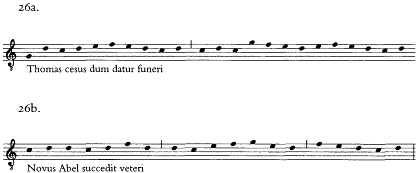
the Mass was copied at St. Peter's by May 1461, this Mass may have accompanied a major event in the term of Pius II; moreover, its probable composer, Caron, may have worked in Rome at about this time. Rather than an association with Thomas Parentucelli, who as Pope Nicholas V was not a martyr,[3] the metaphorical juxtaposition of Thomas with Abel seems a politically apt description of Thomas Palaeologus, the prince of Achaea. He was one of the two surviving brothers of Byzantium's last emperor, Constantine XI, and heir to the throne at Constantinople.[4] Known in Italy as the Despot of Morea, Thomas fled his kingdom in the Peloponnesus in 1460 to avoid the Turkish onslaught led by the sultan Mehmed II.
Abel was in the Middle Ages a symbol both of Christ and of a pilgrim, and because of the primacy he was considered to have in heaven, St. Benedict compared the papacy to him.[5] However, the analogy with Abel is particularly fitting because the sultan's attack followed shortly
[3] However, the humanist Antonio Agli called Nicholas a martyr based not on the shedding of blood but on his efforts as a "guardian and pastor of the Church"; and the pope's biographer Michele Canensi described Nicholas as a martyr on similar grounds (Charles Stinger, The Renaissance in Rome , 173). Epitaphs written for his death do not portray him as a martyr; see Iiro Kajanto and Ulla Nyberg, Papal Epigraphy in Renaissance Rome , 53-58.
[4] The fullest account of the conflict and exile is given in Kenneth Setton, The Papacy and the Levant (1204-1571) , 2: 196-230.
[5] Ad de Vries, Dictionary of Symbols and Imagery , 1.
an armed assault on Thomas by troops belonging to his brother Demetrius. While Demetrius capitulated to Mehmed and offered his daughter for the sultan's harem, Thomas won the undying gratitude of Pius II by bringing with him to Italy the head of St. Andrew, the first apostle and the brother of St. Peter. Described by contemporaries as a man full of grief, Thomas Palaeologus arrived in Rome at the head of a train of seventy horses on 7 March 1461—a date with particular importance in mid-fifteenth-century Rome—and the honors bestowed upon him are reported to have continued for weeks.[6] Pius II presented him with the Golden Rose, the symbol of virtue that popes had long bestowed on emperors and kings, and set him up in the palace near SS. Quattro Coronati with an annual pension of 6,000 ducats.[7]
It could not have been coincidental that Palaeologus arrived in Rome with seventy horses on 7 March, the feast day of St. Thomas Aquinas. Palaeologus had been in Italy long enough for him (or more probably Pius II) to plan the date of his arrival in Rome, as well as all of the festivities arranged to greet him. He had reached Venice by the end of July 1460, and then gone to Ancona at Pius's invitation on 16 November, almost four months before coming to Rome. According to a tradition that extended throughout the Renaissance, important celebrations such as the signing of a treaty or the arrival of a visiting dignitary were often carefully timed so as to coincide with some auspicious anniversary. For his coronation as Holy Roman Emperor in 1433, Sigismund entered Rome on Ascension Sunday; when Paul II honored the treaty known as the Peace of Italy, he did so by issuing a commemorative medal and by publicly announcing the achievement at a time and place with a particular significance for his Venetian heritage—in the basilica St. Mark's on 25 April 1468, St. Mark's day; and in the sixteenth century the Medici rulers Pope Leo X and Duke Cosimo I took particular pains to coordinate ceremonial events and birthdays, election days, or other personal "lucky" days, thereby mak-
[6] Ludwig Pastor, History of the Popes, from the Close of the Middle Ages , 3:250-52.
[7] P. M. J. Rock, "Golden Rose," 629. On a possible association of the Masses on O rosa bella with presentations of the Golden Rose, see Rebecca Gerber, "The Manuscript Trent, Castello del Buonconsiglio, 88: A Study of Fifteenth-Century Manuscript Transmission and Repertory," 128-32.
ing it seem as if the celebration of the moment "had been predestined by divine plan."[8] This type of planning extended beyond human events to architectural ones as well. Leon Battista Alberti, in his treatise On the Art of Building , reports a belief that even the day a building was begun should be carefully considered.[9]
The appearance of Palaeologus and the feast day for Aquinas were both momentous occasions in Rome of 1461. As the deposed heir to the throne of Constantinople, Palaeologus was for Pius a politically useful symbol of the Turkish peril. He would soon assist the pope in trying, albeit fruitlessly, to raise money and men for the crusade. Furthermore, his residence in Rome gave substance to the accord worked out not long before between the Greek and Roman churches. And with regard to Thomas Aquinas, solemn celebrations of his feast day were a modern Roman innovation, dating from guidelines formulated only years before under Nicholas V. As John O'Malley has shown, Nicholas gave the feast a unique prominence, one beyond that of "any other non-biblical saint, even ... Augustine."[10] Accordingly the occasion was to be observed every year in a service at Santa Maria sopra Minerva with the participation of all the curial cardinals. The papal choir sang Mass, there was a sermon, and the Apostolic Palace was accorded a holiday, all of which gave the feast a special liturgical standing. In the sermon he had delivered on this feast day in 1457, the humanist theologian Lorenzo Valla had paired Aquinas with one of the fathers of the Greek church, John of Damascus. In so doing he had attempted to reconcile scholastic thought and methods, as represented by Aquinas, with Patristic teachings. This pairing was but one of five couplings of Greek and Latin fathers, each in one way designed to show how the Greek fathers had contributed to the development of
[8] Roberto Weiss discusses the ceremonies of Paul II in Un umanista Veneziano: Papa Paolo II , 43 and 54-55; on the Medici, see Janet Cox-Rearick, Dynasty and Destiny in Medici Art , 258. Charles VIII doubtless intended to return to Rome from Naples on the Feast of St. Petronilla, the patron saint of the French chapel at St. Peter's, but he arrived the next day, I June 1495 (Kathleen Weil-Garris Brandt, "Michelangelo's Pietà for the Cappella del Re di Francia," 79 and 96, n. 30).
[9] Leon Battista Alberti, On the Art of Building , 59.
[10] John O'Malley, "The Feast of Thomas Aquinas in Renaissance Rome: A Neglected Document and Its Import," 24.
their Latin counterparts.[11] The pope and his resident theologians would have seen the arrival of the Greek Thomas on 7 March 1461 as an exceptional opportunity for associating the Aquinas feast with reconciliation between East and West.
A description of Paleologus as a new Abel is entirely in keeping with contemporary rhetorical practices, which saw in living figures new incarnations of individuals from antiquity. Thus to portray the feared Alfonso of Calabria, who threatened to sack Rome in the summer of 1482, the diarist Jacopo Gherardi called him a "novus Hannibal."[12] Paleologus arrived at a time when martyrdom had become "a leitmotiv of the restored Roman papacy."[13] Rome was then particularly occupied with artistic and literary depictions of martyrs, with Nicholas defining martyrdom broadly in terms of Christian struggles and suffering. Because Aquinas was not a martyr, chants in his honor, however correct liturgically, could not express the attribute that suited the political goals of Pius and the personal situation of Paleologus. The "borrowing" of a cantus firmus from a martyred saint may have seemed a rhetorically appropriate way to honor the arrival of an exiled and betrayed Thomas. Aside from his own sufferings, his responsibility for bringing the head of St. Andrew to St. Peter's would have constituted service enough.[14]
If the Missa Thomas cesus was indeed sung to greet Palaeologus, then the ceremonies of the day symbolically linked three Thomases: Palaeologus arrived on the feast of Aquinas while the choir, doubtless the papal choir, sang a Mass based on a chant for St. Thomas Becket. The choice of cantus firmus welcomed the fugitive Thomas as a living martyr, a "new Abel" victim of a "new Caen." Certain musical features of the Mass seem especially relevant for the occasion. The Credo text is truncated, omitting the "Filioque" clause and the reference to the
[11] Salvatore Camporeale, Lorenzo Valla tra medioevo e rinascimento: Encomium s. Thomae—1457 , 50.
[12] Jacopo Gherardi da Volterra, Il diario romano, 109 .
[13] Stinger, The Renaissance in Rome , 177; see his discussion on 170-79.
[14] Ruth Olitsky Rubinstein, "Pius II's Piazza S. Pietro and St. Andrew's Head," 221-30, describes the importance of this event to Pius and the elaborate ceremonies to greet the samt's head, including the singing of a hymn with a text "in sapphics composed for Pius by Agapito di Cencio dei Rustici" (p. 237).
apostolic church that had long troubled relations between Rome and Constantinople. Ruth Hannas's theory that these Credo deletions were politically motivated, that they were an attempt to conciliate the Greeks, has been rightly qualified.[15] Credo omissions, like those from other parts of the Mass Ordinary, were too common for them all to serve the same purpose. Nevertheless, given the possible connection with Paleologus, this theory is well suited for the Missa Thomas cesus .
Among other potentially relevant musical details, the Mass has an unusual conflicting signature, with one flat in the contra part but none in the cantus, tenor, or bass parts. This combination applies to all sections but the Et incarnatus and the Pleni-Osanna I, which have no signature flats at all.[16] This appears to have little to do with the relative range of the contra part. In some movements the range of the contra voice (G-a') is just one note higher than that of the tenor (F-g, or G-g); in others (Et in terra and the entire Sanctus) the contra and tenor move in identical ranges. Thus it is unlike Compère's chanson Ung franc archier , a piece with one flat for the superius, tenor, and bass but two for the contra. Compère thus accommodates a canon at the fifth below between the superius and contra. The single flatted part in the Missa Thomas cesus , as one might imagine, causes several problems of musica ficta that can only be solved by negating the flat. Example 27 presents one instance from the Christe that results in a simultaneous


A symbolic meaning of the flatted part seems plausible,[17] in particular, one related to the oration on St. Thomas Aquinas preached by Lorenzo Valla in 1457. After pairing Aquinas with John of Damascus as the last of the five Greek-Latin theological couples, Valla compared each couple to a representative musical instrument; and then, pursuing
[15] Ruth Hannas, "Concerning Deletions in the Polyphonic Mass Credo," 155. Replies came from Sylvia Kenney, Walter Frye and the Countenance Angloise , 170-72; Margaret Bent and Ian Bent, "Dufay, Dunstable, Plummer—A New Source," 413-14; and Geoffrey Chew, "The Early Cyclic Mass as an Expression of Royal and Papal Supremacy," 260-62.
[16] There is also a flat at the very beginning of the tenor part of the Kyrie II, for the first line only, a line without any Bs to flat. This seems likely a scribal error and a sign of how rare this conflicting signature was.
[17] Edward E. Lowinsky discusses symbolic usage in "The Function of Conflicting Signatures in Early Polyphonic Music," 250-54.
EXAMPLE 27. Ficta problem at cadence in Missa Thomas cesus , Christe, mm. 6-9

his musical metaphor, he assigned to Aquinas and John of Damascus the extraordinary role of the fifth tetrachord, a complex allusion to the Boethian double octave and the greater perfect system. In his study of Valla's oration, Salvatore Camporeale suggests the following interpretation: Since the four tetrachords of the Boethian double octave (A to D, D to G, and so on), do not account for the note


Musical symbolism of another kind may have shaped the setting of the cantus firmus. Each time the B section of the cantus firmus makes its appearance in a cut-C section, the first two notes, C-D, are emphasized. These opening two pitches, although they do not constitute a phrase unit either syntactically or musically in the chant, are persistently isolated. Several breves of rest separate these notes from those that follow, and they are themselves set in long values. Counting the number of breves allotted to each of these two notes, they last 3+3 breves at the start of the Christe, 4+4 in the Qui tollis, 6+6 in the Et
[18] Camporeale, Lorenzo Valla tra medioevo e rinascimento , 52-54.
EXAMPLE 28. Comparison of Missa Thomas cesus with Caron, Le despourveu infortunée , and Joye, Mercy, mon dueil
EXAMPLE 28A . Le despourveu infortunée , mm. 1-9

EXAMPLE 28B . Missa Thomas , Qui tollis, mm. 1-10

EXAMPLE 28C . Missa Thomas , Et incarnatus, mm. 1-11

EXAMPLE 28D . Le despourveu infortunée , mm. 4-11

EXAMPLE 28E . Missa Thomas , Benedictus, mm. 1-7

EXAMPLE 28F . Mercy, mon dueil , mm. 1-7

incarnatus, 3+4 in the Benedictus, and 4+4 in the Agnus III. One wonders if what is being emphasized is not the name "Thomas" spelled with the hexachord syllables sol and la. Parallels occur later in Josquin's Missa Hercules and also at the end of Du Fay's motet and Mass Ave regina , when the "fa" syllable of his name occurs on an


Finally, a possible musical-textual reference to the deposed ruler points to Caron as the composer of the Mass. By quoting chansons in the contrapuntal voices of polyphonic Masses, as I argue in chapter 10, Renaissance composers could allude to the unsung chanson texts as a commentary on the text of the Mass Ordinary. Chanson quotations (or citations of chant) could also refer to a specific event or person. As in the Masses by Caron discussed in chapter 10, the Missa Thomas appears to quote from one of Caron's own chansons. Le despourveu infortunée by Caron has both melodic and rhythmic identity in two voices with the Qui tollis and the Et incarnatus movements. Example 28a shows the superius and tenor voices of this chanson. They match the opening superius and contra duet of the Qui tollis for the first phrase (Ex. 28b). The latter half of this chanson phrase returns at the beginning of the Et incarnatus, again with a note-for-note identity, except for the metrically elongated cadence (Exs. 28c-d).
The text of the chanson could not be more appropriate as an expression of the state of exile in which the aggrieved Thomas Paleologus found himself:
The unfortunate deprived one,
Incessantly surrounded
By grief, regrets, and tears,
I find myself shut out from any succour,
And abandoned to all evil.
I am piteously rewarded
And very badly cared for;
Fortune by her evil turns makes me
The unfortunate deprived one, etc .
More than anyone else I am badly dealt with,
For Hope has turned its back on me;
So my situation goes contrarily along.
I can with reason blame Love,
When he appointed me to be
The unfortunate deprived one, etc .[19]
By association with the Mass text, the allusion of the chanson melody could thus be understood in the Qui tollis as a plea for mercy on behalf of "the unfortunate one deprived" of his kingdom; and in the Et incarnatus as a statement of Paleologus's personal fate: "And he was incarnate the unfortunate deprived one." This tune, or one related to it, begins the Benedictus (Exs. 28e-f). Among the possible references is the tenor of Joye's Mercy, mon dueil , "Have mercy, my grief, I beg of thee."[20]
Aside from the citation of one of his own chansons, trait after trait of the Missa Thomas cesus appears in the five Masses securely attributed to Caron. The handling of the tenor and the relatively frequent cadences are both characteristic of Caron. His Masses never repeat the Osanna I as the Osanna II; as in the Missa Thomas , the Osanna II receives its own setting. And as happens in the Missa Thomas , the Pleni and Benedictus of Caron's Missa Sanguis sanctorum both combine with the Osanna that follows. With regard to the three sections of the Kyrie, all of those composed by Caron are for four voices rather than four in the Kyries and only three in the Christe; it is also characteristic, though not uniform, for all voices to begin these sections together.
Conflicting signatures : The pattern of conflicting signatures has ample parallel in Caron's Masses. There are conflicting signatures in the Missa Clemens et benigna (



Mensuration signs : Caron's mensural tendencies prevail in the Missa Thomas (Table 23). The similarities are strong in the Kyrie and Gloria,
[19] The translation is by Max Knight, in Howard M. Brown, A Florentine Chansonnier from the Time of Lorenzo the Magnificent: Florence, Biblioteca Nazionale Centrale MS Banco Rari 229 , text volume, p. 251.
[20] Translation in Leeman Perkins and Howard Garey, The Mellon Chansonnier , 2: 278-79.
a bit less so in the Credo, a movement marked by its lack of uniformity in Caron's Masses. Only the Agnus departs from mensural patterns that occur in Caron's Masses; but here as well, since no two Masses by Caron have an identical mensural scheme, this is not a serious difference. Indeed, if there is an identifiable mensural pattern in Caron's Agnus movements, it is that they replicate the sequence of mensural signs just heard in the Sanctus: The Agnus movements of the Missa Clemens, Missa Jesus autem transiens , and also the Missa Thomas simply repeat the succession of mensural signs used in the Sanctus. The other Masses diverge only on the use of a diminution sign for the final section of text.
Structural parallels : Caron never repeats the music from one sub-movement in another. Nevertheless, in two of his Masses there are sections with significant structural parallels. Caron pairs the Gloria and Credo of his Missa Jesus autem transiens by giving them the same tenor (as does Du Fay in his L'homme armé and Se la face ay pale Masses); and for the Cum Sancto and Confiteor sections, the contrapuntal voices are extremely close.[21] Another instance does not involve exact melodic repetition in any voice. In the Sanctus and Agnus of the Missa L'homme armé , the beginnings of two submovements are paired struc-turally (Table 24). The first twenty-three measures of the Sanctus and Agnus I and the first twenty-two of the Benedictus and Agnus II adhere to similar plans. Caron's choice of phrase length, cadence points, contrapuntal pairings, rhythms and meters, and textures follow each other almost measure by measure. Only once do the similarities extend to motive, and only for a brief instance of mid-phrase counterpoint.
In this latter structural sense the Missa Thomas cesus has two pairs of related movements. The Qui tollis and Benedictus follow each other phrase by phrase, as do also the Pleni and Agnus II. In these movements the composer avoids outright duplication, creating an aural impression of variation rather than repeat. For the most part the parallels do not extend to motives, although the cantus firmus segments are the same, and the first superius measures of the Benedictus clearly relate to those of the Qui tollis. Also in the Pleni and Agnus II the contra parts follow each other closely at the beginning, as do the bass parts. in the
[21] James C. Thomson, An Introduction to Philippe (?) Caron , 11, considers the Confiteor a "polyphonic parody" of the Cure Sancto.
EXAMPLE 29. Cadential pattern in (a) Missa Thomas , Patrem, mm. 65-68 (contra omitted); and (b) Patrein, mm. 72-75 (contra omitted)
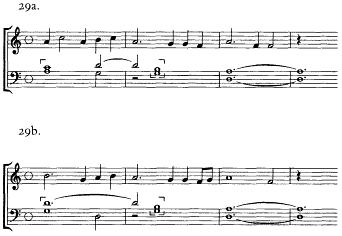
last duet.[22] These twosubmovements are the only times that the B phrase of the cantus firmus occurs in tempus perfectum . But instead of pairing these sections by building them out of the same motives, the composer depends on correspondences between cadences, the presence or absence of strict imitation, the use of duets, and the equality of phrase lengths. Details of the similarities are listed in Table 25.
Cadence type : This G-mode Mass has a number of unusually prominent Phrygian cadences. There are twenty-three in all, one in every submovement except the Qui tollis, and as many as four in the Patrem. Fourteen of the cadences take the distinctive three-voice form shown in Example 29, what I shall call a "plagal-Phrygian cadence," because while the tenor and cantus cadence on a, the other voices make a plagal movement from G to D.[23] It receives particular emphasis throughout the Credo, where it is heard five times because the composer
[22] Compare the Pleni, mm. 1-6 and 21-23; and Agnus II, mm. 1-7 and 21-23.
[23] This cadence, called by theorists simply a clausula in mi , was common well into the sixteenth century; see Bernhard Meier, The Modes of Classical Vocal Polyphony , 96-99.
chose to repeat the underlying cantus firmus segment. Although there are no

No composer made greater use of the plagal-Phrygian cadence than Caron. Most of his Masses have many: The Missa L'homme armé has nine, the Missa Jesus autem transiens has ten, as do the four extant movements of the Missa Sanguis sanctorum , and the Missa Clemens et benigna has twelve. In this sense the Missa Accueilly is unusual because it has only one. As in Caron's chansons and the Missa Thomas , the cadence often comes in Caron's Masses during the penultimate phrase (as in Ex. 29).[24] Busnois, in so many ways stylistically like Caron, also relies on this cadential pattern more than others. Although in his Missa L'homme armé there are only three, and in the four movements of the Missa Quand ce vendra there are six, sixteen occur in the Missa O crux lignum . Yet Busnois differs from Caron cadentially in that he is more apt to repeat cadences on the same pitch, and other aspects of the Missa Thomas —the mensuration scheme, the separate Osanna II—are not typical of Busnois. In the Naples L'homme armé Masses the presence of this cadence varies greatly: Number 1 has only one, number 6 has eight or nine, while number 2, stylistically the most progressive, has seventeen (a total that excludes from consideration the incomplete Kyrie I).[25] And Vincenet, who is too prone to duets to be confused with Caron (along with other formal differences), has eleven in his Missa O gloriosa regina .
Among other composers, this type of Phrygian cadence is less evident in the Masses of Johannes Touront, a master who otherwise bears
[24] Regarding the prevalence of this cadence in Caron's chansons, see Thompson, An Introduction to Philippe (?) Caron , 38. He and others have dubbed this an "undermined" cadence, referring to the (presumed) necessity to lower the seventh degree at cadences, an assumption not always warranted.
[25] Regarding the stylistic differences of Mass no. 2, see Cohen, The Six Anonymous L'Homme Armé Masses in Naples, Biblioteca Nazionale, MS. VI E 40 , 44 and 60; and Barbara Haggh, Communication to JAMS . And in the anonymous SPB80 Missa (fols. 122-29) motivically related to Caron's Masses, this cadence type occurs only once.
melodic and rhythmic comparison with Caron and Busnois. He has many Phrygian cadences in his Missa Monyel and Missa Tertii toni , but few in this pattern. There are four of these cadences in Ockeghem's Missa Ecce ancilla Domini , four in his Missa L'homme armé , five in the Missa Mi mi (on E), and four in the three movements of his Missa (à5). However, aside from his use of this cadence being more temperate than Caron's, Ockeghem treats it in a different manner structurally. He customarily locates these cadences either well into the interior of a submovement or at the very end. Mass cycles by Du Fay have comparatively few Phrygian cadences and almost none of this plagal variety (which is yet another point of contrast with the Missa Caput once attributed to him—it has nine of these cadences). Nor is it prevalent in the Masses of Faugues.
Motives
Caron's melodic stamp appears in several movements. The Pleni of the Missa Thomas and the Benedictus of Caron's Missa Clemens have the same beginning (Ex. 30). On the one hand, this particular melodic similarity is not by itself significant, because the motive is common, especially in settings of the Sanctus (chapter 6, Ex. 5). On the other hand, the coincidence extends beyond the opening motive. The only G-mode occurrences of the motive (it is most frequent in mode 5) aside from these are in Caron's Missa L'homme armé (Sanctus, m. 6) and earlier in the Missa Clemens at Domine Deus.[26] The rhythmic cast of this opening and the harmonic context contribute to the similarity here, as they do also in two other related movements, the Missa Thomas Agnus III and the Osanna I of the Missa Accueilly m'a la belle (Ex. 31), which are virtually identical in their openings. This last tune turns up again in the Christe of the anonymous three-voice Missa in SPB80 on folios 122-29 (chapter 6, Ex. 7).
Caron returned to this opening for the Kyrie II of the Missa Sanguis sanctorum (as in the third segment of Ex. 32b).[27] This time the rhythm is more animated. However, the Kyrie for this Mass also presents an-
[26] The continuations of each line extend the resemblance, and a neighboring movement, the Osanna I, also has a similar beginning.
[27] And also the four-voice entry in the Christe of the Missa Accueilly m'a la belle .
EXAMPLE 30. Motivic comparison of (a) Missa Thomas , Pleni, mm. 1-5; and (b) Caron, Missa Clemens , Benedictus, mm. 1-5
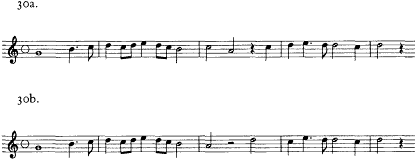
EXAMPLE 31. Harmonic and motivic comparison of (a) Missa Thomas , Agnus III, mm. 1-6; and (b) Caron, Missa Accueilly , Osanna I, mm. 1-6
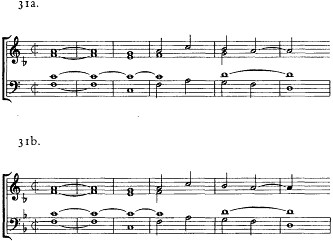
other type of motivic parallel with the Missa Thomas . It does not seem to matter that the two Masses are in different modes. Caron follows the same motivic series to begin the three sections of the Kyrie in each Mass, one centered on f, the other on g. Later in the Missa Sanguis sanctorum and the Missa Thomas there is a shared conclusion for the Sanctus. Each concludes with the plagal-Phrygian cadence described
EXAMPLE 32. Motivic comparison of (a) beginnings of Missa Thomas , Kyrie I, Christe, and Kyrie II; with (b) Caron, Missa Sanguis , Kyrie I, Christe, and Kyrie II
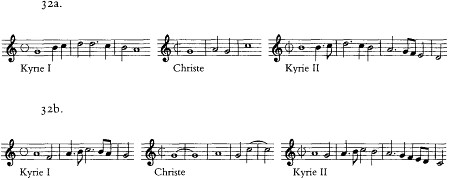
above, plus the postcadential descending sixth (from f to a) popular in chansons of Busnois, Hayne, Compère, and others. These twin cadences occur despite the different modes of the Sanctus and of the Osanna, which follows immediately.[28]
As in the Missa Jesus autem transiens and the Missa Thomas , the "second tune" of the L'homme armé Masses occupies an important position as an interior motive. It is not simply that this melodic cliché itself is present but that the way in which it is handled in both Masses is the same. When the tenor cantus firmus reaches the note d, usually at a cadence point, the top voice launches into this familiar motive or a variant. Example 33 juxtaposes the Missa Jesus Kyrie I (mm. 12-16) and the Missa Thomas Patrem (mm. 4-8); and the Missa Jesus Sanctus (mm. 30-34) and Missa Thomas Et in terra (mm. 29-34). The similarities in this last example extend to the counterpoint.[29]
[28] In the Missa Sanguis sanctorum this figure also follows this type of Phrygian cadence in the Et in terra at rehearsal letter G in Thomson's edition (Philippe Caron, The Complete Works of Philippe (?) Caron ).
[29] Other instances are found in the Missa Jesus : Confiteor (m. 12), Sanctus (m. 16), and Agnus I (m. 12); and the Missa Thomas : Christe (m. 28), Et in terra (m. 15), Et incarnatus (m. 62), Confiteor (m. 4), Benedictus (m. 43), and Agnus I (m. 30). The last two omit the first note.
EXAMPLE 33. Motivic comparison of Missa Thomas and Caron, Missa Jesus
EXAMPLE 33A . (i) Missa Thomas , Patrem, mm. 4-8, and (ii) Caron, Missa Jesus , Kyrie I, mm. 12-16

EXAMPLE 33B . (i) Missa Thomas , Et in terra, mm. 29-34, and (ii) Caron, Missa Jesus , Sanctus, mm. 30-34

Imitation
In general, imitation intrudes only sporadically in tutti passages in the Missa Thomas and in all of Caron's Masses. It stands out when it occurs. In duos and trios imitation does not always appear at phrase beginnings, and it is frequently associated with sequential patterns, often at the distance of a single minim or semibreve a fifth or an octave apart. Imitative motives range from improvisatory formulas to more contrived, and less strict, counterpoint. The same can be said for counterpoint that proceeds in parallel thirds, sixths, or tenths. One can generalize that throughout the latter half of the century, composers like Hayne who favored these sweet consonances also used imitation in more or less
EXAMPLE 34. Comparison of cadences in (a) Caron, Missa Clemens , Osanna II, mm. 9-10; and (b) Missa Thomas , Et incarnatus, mm. 60-64
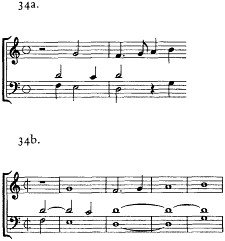
equal quantities, as if one facilitated the other. Speaking specifically of Caron's Mass style, passages of imitation and parallel consonances are absent in equal measure. They come and go discretely.
Characteristic of polyphony in the generation before imitation became pervasive is a more disjunct approach to phrasing. Often after a cadence the lower voices engage in a breve or two of contrapuntal filler leading to an entrance with the next phrase of text. At times transitions are nothing more than a sustained pitch or plagal fall in the bass; sometimes they rely on a fauxbourdon cadential formula or on more extended passages of free counterpoint. Occasionally there is no transition whatsoever, only a sustained note or chord in the lower voices, or in the duets not even that. Without relying on imitation to achieve elided phrases, Caron's Masses and the Missa Thomas often introduce the superius in the midst of a cadence in the lower voices. While the tenor is suspended against the bass, the superius enters a fourth above the tenor, creating a dissonant diminished fourth when the subsemitonium modi is raised for the cadence. In Example 34 I have selected two from many because of the characteristic dotted rhythmic pattern of the superius.
Against all of these similarities, the only discrepancy that the Missa Thomas has with Masses ascribed to Caron concerns the number of voices used to begin movements. Caron favors duet beginnings for the Gloria, Credo, Sanctus, and Agnus, while the principal movements of the Missa Thomas all begin with four voices. Compared to the wealth of stylistic resemblances, this does not seem a serious idiosyncrasy.
Caron and Puyllois
That Caron may have written the Missa Thomas for a Roman event has obvious biographical implications. Together With other features of SPB80 it suggests that Caron spent time in Rome: As discussed in chapter 6, there is the series of motivic parallels between Masses by Caron and a second anonymous Mass (fols. 122-29), a Mass also transmitted in the earliest layer of SPB80; and layer 2, presumably based on a manuscript copied by Philippus de Holland, contains the Missa L'homme armé . Thus far suggestions that Caron worked in Italy have centered on the great number of his chansons that survive in Italian—especially Florentine—manuscripts (thirteen in Flor229, seventeen in Paris 15123), on the corresponding scarcity of his chansons in Burgundian sources, and on the Italian text for his song Fuggir non posso .[30] In this regard the evident modeling between the beginning of Pietrequin's farewell chanson Adieu Florens la jolie (preserved in Flor229) and Caron's Mourir me fault is suggestive.
Some unusual iconographical evidence supports the conclusion that Caron did in fact work in Italy, near enough to both copies of his Missa L'homme armé that the scribes apparently included a portrait of him. Although Ausquier copied eighty compositions in SPB80, he left only one attribution, that to "F. Caron" at the beginning of Caron's Missa L'homme armé .[31] Accompanying this attribution is what I take to be Caron's likeness in the margin directly below the superius's decora-
[30] See, for instance, Perkins's comments in Perkins and Garey, The Mellon Chansonnier , 1:9-10.
[31] There is no question that Ausquier wrote an "F" rather than a "P." For comparison, there is the nearly identical "F" he wrote for Puyllois's Flos de spina at the beginning of the tenor. In contrast, for the Patrem of Caron's Missa L'homme armé (fol. 103), the capital "P" that Ausquier wrote for the second contra is unmistakable.
tive letter "K" for the Kyrie I (Figure 13). It is definitely not one of Ausquier's grotesques, nor does it appear to be a caricature, but rather a profile of a man dressed in a cassock. There is a comparable portrait of a cleric in the other copy of the Caron Missa L'homme armé , that in the manuscript CS14. Frowning rather than smiling, hooded rather than bare-headed, left profile rather than right, this picture in the contra initial of the Et expecto is still more clearly a portrait (Figure 14).
A Roman period for Caron would explain several striking melodic resemblances between his works and those by Puyllois. The strongest parallels exist between chansons, a source for comparison that we lack for Faugues since there are none that survive with attributions to him. The remarkable relationship between Puyllois's De madame au biau corps and Caron's Se brief puys ma dame voir extends to almost every phrase of Caron's chanson.[32] Both are settings of octosyllabic rondeaux cinquains that express the desire to see an absent (and beloved) woman. But if one were dependent on the copies of the two chansons in their respective complete editions, that is where the visible similarities would end. The many links between the first phrases are effectively disguised by the drastically divergent editorial policies. These notational differences have been eliminated in Example 35. Omitting for the moment the segments in brackets, the beginnings and endings of this phrase correspond in all voices.[33] Differences in mensuration do not disturb the easily audible connections. But even the middles of the two phrases are related: one is little more than a transposition of the other, as the appropriate solmization syllables would attest. For his verse 3 Caron may have derived his motive from the tenor of De madame (Ex. 35c); at the conclusion of the two chansons, the tenor and superius voices again parallel each other.
Caron subsequently appears to cite both of these chansons in his Missa Clemens et benigna . Although the title of the Mass is that of a Marian Osanna trope, the notes of the cantus firmus bear no relation to any known chant. Instead the tenor and bass voices paraphrase Se
[32] Se brief puys exists in four sources, anonymously in Rome 2856 and Seville 5-1-43, ascribed to Busnois in Paris 15123 and to Caron in Flor229. I agree with Howard Brown's assessment that it is "probably by Caron" (A Florentine Chansonnier , text volume, 242); the case for Caron is strengthened by the relationships described below.
[33] The contra of De madame is that from Tr90.
EXAMPLE 35. Comparison of the first phrases of Puyllois, De madame au biau corps , and Caron, Se brief puys ma dame voir
EXAMPLE 35A . Puyllois, mm. 1-3, 5-7 (notes in brackets are transposed up a fifth)

EXAMPLE 35B . Caron, mm. 1-9 (notes in brackets are untransposed)

EXAMPLE 35C . (i) Puyllois, mm. 21-23; and (ii) Caron, mm. 22-26

brief puys ma dame voir at the beginning of each movement, most obviously in the Kyrie I (compare Exs. 36a and b). At the same time, as I have indicated elsewhere, the súperius voice quotes from a different "lady" chanson, either the anonymous Hélas mestresse m'amie, que j'ayme (Pav362) or its motivic twin, Madonna par la torno (Escorial), also
EXAMPLE 36. Motivic comparison of Caron, Missa Clemens , and Puyllois, Se brief puys ma dame voir : (a) Caron, Kyrie I, mm. 1-5, tenor and bass; (b) Puyllois, mm. 1-6, tenor and bass; and (c) Caron, Patrem, mm. 11-17
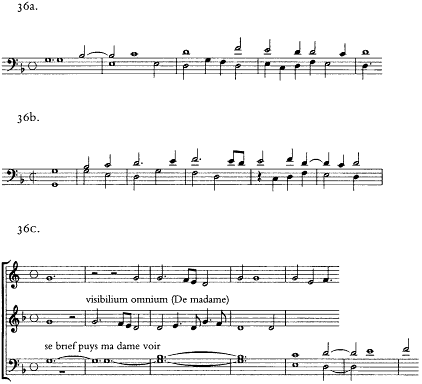
anonymous.[34] Caron thus engages in a double allusion, with different voices singing from different chansons that fit textually with the sacred Marian text identified in the title. The texts of the trope Clemens et benigna and Se brief puys ma dame voir sound the same themes, principally that of praying to Mary (or the desired mistress) for clemency (or pity) to convert sadness to happiness. As the chant asks Mary to "restore us to joy from misery" ["Nos a miseria Reduc ad gaudia Maria"], the
[34] Christopher Reynolds, "The Counterpoint of Allusion in Fifteenth-Century Masses," 237-39. The text "clemens et benigna" is found in manuscripts from the eleventh to the sixteenth centuries and is printed in Clemens Blume and H. M. Bannister, eds., Tropi graduales , 530.
chanson declares that at the sight of "my lady ... My grief will certainly waiver ... Joy will then take my being in hand" [Certes, mon dueil chancillera ... Leysse en main prendra m'avoir].
At the tenor's first entrance in the Patrem, Caron refers to the chanson of Puyllois, De madame (compare Exs. 35a and 36c). While both of the upper voices imitate the superius of De madame , the rhythms are particularly close in the contra. Caron placed this citation at the Credo text "Et visibilium omnium," thereby conjoining the idea of "all things visible" and the wish to "see" his Lady expressed in the first verse of his chanson (cited in the tenor).
Beyond these musical ties, the title of Caron's chanson may itself include a double allusion to Puyllois. Unlike the Du Pay chanson Se madame je puis voir (which has nothing to do musically with Caron or Puyllois), the title Se brief puys ma dame voir perhaps calls attention to the "ma dame" of Puyllois's chanson by virtue of its grammatical position within the verb "can ... see." The more punctilious scribe of Rome 2856 corrected the first verse to read Se brief je puys voir madame . But perhaps the two verbs "puys voir" also pay homage to Puyllois by playing on the first letters and vowel combination of his name, Puyllois. Combinations of internal "uy" and ending "oi" vowels resound throughout Caron's chanson:[35]
En luy declairant mon voloir .. . (lines 5 and 7)
Mon estat luy fera scavoir . (line 10)
Mon cuer, qui se fera valoir .. . (line 14)
This and other kinds of word play, whether anagrams, puns, or acrostics, had a vital tradition in French literature from the chansons of Machaut to those of Busnois and from the poetry of the Roman du Fauvel to that of Rabelais.[36]
Se brief puys ma dame voir is not the only chanson by Caron to quote
[35] The desire to include as many "uy-oi" combinations as possible may explain the unusual repetition of line 5 as line 7. The same combination of syllables occurs in Horlay's chanson Je ne "puis avoir" ung seul bien , copied in EscB in a group of eight chansons by Horlay and Puyllois. Later verses combine "celui sans moien " (line 5) and "Onque je soy " (line 10). Horlay's chanson seems to parody the beginning of Puyllois's Je ne puis (no further text), especially in the version copied in Tr90.
[36] See Paula Higgins's discussion of word play with particular regard to Busnois and his Jacqueline songs in "Antoine Busnois and Musical Culture in Late Fifteenth-Century France and Burgundy," 168-74 and 196-201.
EXAMPLE 37. Motivic comparison of (a) Puyllois, De madame au biau corps , phrase 2, mm. 7-10; and (b) Caron, Du tout ainsy , phrase 2, mm. 11-20
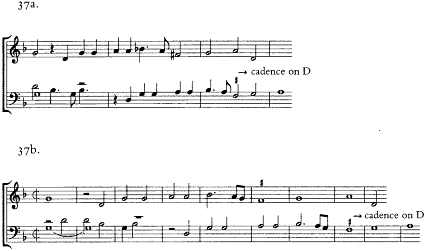
EXAMPLE 38. Motivic comparison of (a) Caron, S'il est ainsy , mm. 1-5; and (b) Puyllois, Si ung bien peu , mm. 1-9

De madame . The second phrase of Caron's Du tout ainsy and the second phrase of Puyllois's De madame have the same imitative motive (Ex. 37). Even Puyllois's contra (which survives only in Escorial) is briefly present in Caron's chanson. This melodic borrowing may have a textual basis, in that the idea of service in the Puyllois text—"De madame au biau corps gentil / Ay servi par engien soutil"—also exists in "Du tout ainsy qu'il vous plaira / Sur moi commander ou defendre."
Like Du tout ainsy , Caron's chanson S'il est ainsy also has contrapuntal similarities with chansons by Puyllois. Caron appears to parody a contrapuntal figure that had particular significance to Puyllois at the beginning of his chanson S'il est ainsy (Ex. 38). As in Si ung bien peu d'esperance the top voices descend from a to e then d, then move back up to c' before cadencing on a (not shown); and the tenor provides a contrary motion, crossing over the superius d' with leaps up to f'. In other works Puyllois has the same converging counterpoint: the beginning of Quelque langage, Victimae paschali laudes at the phrase "Dic nobis Maria, quid vidisti," and the Missa at "Quoniam tu solus Sanctus."
Even though these works of Caron and Puyllois are not preserved in SPB80, I have dwelt on the musical resemblances between them because they suggest that Caron worked not merely in Italy but, at least for a time in the early 1460s, specifically in Rome in close proximity to Puyllois. Caron's presence in Rome may further explain the strong connections between his Masses and the anonymous Missa in SPB80 on folios 122-29, and also the possible portraits that scribes copied in Caron's Masses in SPB80 and CS14.
Chapter Nine—
Martini:
Association and Attribution
Two Masses in the first fascicles of SPB80 can be linked to Johannes Martini: the Missa Au chant de l'alouete that begins the manuscript and also the anonymous Sanctus and Agnus on folios 21-25. While the former can be attributed to Martini on stylistic grounds, the fragmentary Mass, recently recognized in Speciálník with an attribution to "Lanoy," distinctly shows Martini's influence. The attribution to Lanoy, doubtless Martini's friend Colinet (Karulo, Karolo, Karolus, and Carlo) de Lanoy, occurs in Speciálník both in the alphabetical index and over the Credo, a movement that does not appear in SPB80.[1]
Lanoy, Missa Fragment, SPB80, Folios 21-25
The Lanoy Sanctus and Agnus originally belonged to one of the most modem Masses in the manuscript. Truncated when two fascicles of SPB80 were removed, these movements are now sandwiched in between the partial copy of Du Fay's Missa Ave regina coelorum and his motet Ave regina coelorum . Along with the complete Kyrie, Gloria, and Credo, the excised folios also must have contained the missing superius of the Sanctus and Pleni. All three voices survive for the
[1] Speciálník has only the Credo and Sanctus movements (on fols. b7v-b11r; or pp. 48-55). The concordance of the anonymous Sanctus in SPB80 with the attribution in Speciálník was found by Bob Mitchell. I would like to thank Rob Wegman for this information and for graciously providing me with a transcription of the Credo.
Osanna, Benedictus, and entire Agnus. From these sections and those in Speciálník, it is clear that the Mass—with a g final and a two-flat signature in all voices[2] —was not based on a cantus firmus in the tenor, nor does it appear to have had a motto.
Certain stylistic traits of the Mass, as noticed by Rob Wegman, resemble another work copied in the 1470s, the Missa Quinti toni by Ockeghem.[3] The Missa Quinti toni also has no cantus firmus, although, unlike the SPB80 Missa , it does have a perfunctory motto in the bass, consisting of three triadic descending notes,





Wegman's valuable observations not withstanding, Martini exercised a much greater influence over Lanoy than did Ockeghem. To begin with a few random observations, neither of Ockeghem's three-voice Masses, and neither of his Masses in


[2] The tenor occasionally has only one flat.
[3] Rob Wegman, "An Anonymous Twin of Johannes Ockeghem's Missa Quinti toni in San Pietro B 80." This article includes a transcription of the surviving parts. The Missa Quinti toni was copied into Br5557 between 1476 and 1480 (Rob Wegman, "New Data concerning the Origins and Chronology of Brussels, Koninklijke Bibliotheek, Manuscript 5557," 14).
[4] On this basis Wegman argued not only that these Masses were paired as "twins" but also that Ockeghem is the most probable composer (Wegman, "An Anonymous Twin," 25-48).
Benedictus in coloration, nor with the dotted rhythmic pattern which in this Mass begins both the Benedictus and the Osanna. He prefers longas and breves. This opening rhythm is perhaps most typical of chansons by Hayne, but Martini was also familiar with it, using it both in chansons and Mass movements.
The Agnus II violates many stylistic norms for Ockeghem's settings of this text. In no Agnus II in



But the most striking differences with Ockeghem's style are in the cadences. The cadential patterns of the Missa differ from Ockeghem's in their counterpoint, their much greater frequency, and the regularity with which they occur on the final. Taking the last point first, the Missa clearly demonstrates the hand of another composer at the penultimate cadence of each section. They occur much closer to the final cadence than one finds in Ockeghem, and they are invariably on the final. Just as predictably Ockeghem will turn to another scale degree, often the fifth. The strong emphasis of the final in the Missa extends to the last three cadences of the Agnus I and III and the last four of the Benedictus. The greater tonal feel of the composer of this Missa marks him as a younger man than Ockeghem. Indeed, some of the unconventional cadential counterpoint indicates a youthful inexperience with a three-voiced texture. In the comparison of cadences in Example 39, the un-Ockeghemian leaps away from the final stand for the Missa , and the elegant, graceful, and unsurpassed ability to suggest closure without resorting to a suspension cadence represents the Missa Quinti toni . Martini was quite capable of the former, as a cadence from Il est tousjours (Ex. 39c) attests.
In the absence of a cantus firmus or a unifying motto, this Mass is
EXAMPLE 39. Comparison of cadences by Lanoy, Ockeghem, and Martini: (a) Lanoy, Missa (SPB80, fols. 21-25), Osanna, mm. 3-5, and Agnus III, mm. 21-22; (b) Ockeghem, Missa Quinti toni , Agnus I, mm. 42-45; and (c) Martini, Il est tousjours , mm. 27-28
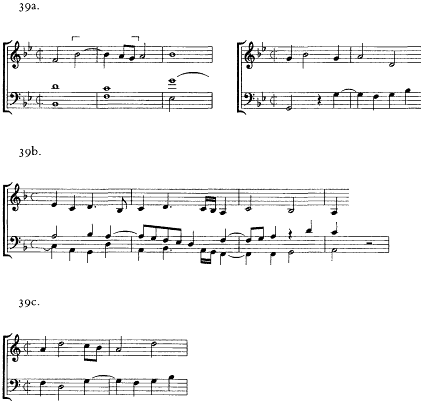
unusually chansonlike in the details of its counterpoint. Several contrapuntal and melodic passages in the Mass can be found almost note for note in two chansons by Martini. Very much like both Hayne and Martini is one particular postcadential syncopated figure in the Agnus I. Hayne had used it in De tous bien plaine after the cadence marking the end of the first phrase. In the Agnus I it also comes after the first phrase, accompanied in parallel tenths (Ex. 40), which is exactly the
EXAMPLE 40. Comparison of postcadential phrases in (a) Lanoy, Missa , Agnus I, mm. 4-8; and (b) Martini, Tousjours bien , mm. 9-14 (transposed down a major second)
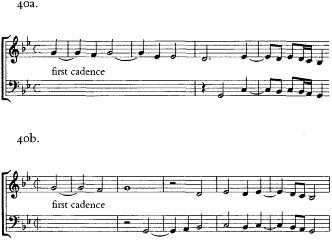
way we find it in Martini's Tousjours bien (here transposed down a major second).[5] This chanson and the Missa share another contrapuntal segment, a point of imitation that commences with a cadential suspension (Ex. 41). Once again I have transposed the chanson.[6] While the motivic and imitative use of suspensions exists in the works of most contemporaries of Busnois, it is only one hallmark of Martini's style present in this work.
Hayne may ultimately be the stylistic inspiration for another phrase in the Agnus I, but this rising sequential figure also turns up in a Martini chanson, the (presumably) instrumental Fuge la morie (Ex. 42). Further, two of the recurring bass motives in Fuge la morie appear in the Missa . The head motive of the chanson and the beginning tenor motive of the triple meter section in the Agnus II are closely related (Ex. 43). Then, after three statements of this idea in Fuge la morie , the bass takes up a second motive (mm. 15-18), which begins the Agnus II
[5] This figure also appears in Martini's Se mai il cielo e fati fur benigni (Flor229, no. 5), mm. 34-37.
[6] See also Martini, Malheur me bat (Flor229, no. 11), mm. 38-42.
EXAMPLE 41. Comparison of counterpoint in (a) Lanoy, Missa , Agnus II, mm. 13-17; and (b) Martini, Tousjours bien , mm. 19-23
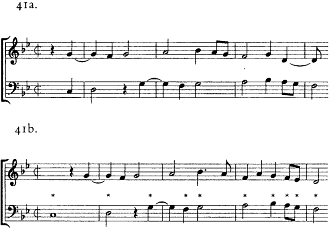
EXAMPLE 42. Comparison of sequential figures in (a) Lanoy, Missa , Agnus I, mm. 27-31; and (b) Martini, Fuge la morie , mm. 44-48 (rebarred)
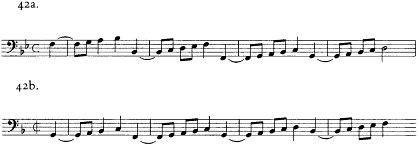
EXAMPLE 43. Motivic comparison of (a) Lanoy, Missa , Agnus II, mm. 36-40; and (b) Martini, Fuge la morie , mm. 1-3
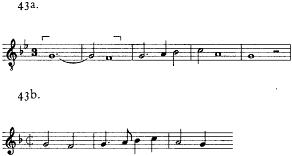
EXAMPLE 44. Motivic comparison of Lanoy, Missa, and Martini, Fuge la morie
EXAMPLE 44A . Lanoy, Agnus II, mm. 1-3

EXAMPLE 44B . Lanoy, Benedictus, mm. 31-34

EXAMPLE 44C . Martini, Fuge la morie , mm. 15-18

and also appears in the Benedictus (mm. 31-34) with a similar contrapuntal treatment (Ex. 44).[7]
In one imitative passage Lanoy quotes directly from his popular chanson, Cela sans plus , but here too the imprint of Martini is visible. In the Benedictus the second entrance of the superius is quickly answered by the tenor. These voices cite the second phrase of the chanson (Ex. 45a). Contrapuntal citations were not limited to the begin-
[7] The title Fuge la morie occurs in the Ferrarese source Rome 2586, while in the later Spanish source, Segovia (fol. 189v), it is called Scoen vint . Jacobus Barle, about whom nothing is known, wrote what appears to be a parody of Fuge la morie in his presumably instrumental work Moyses . It appears in Segovia with that title on fol. 191, two folios after Fuge la morie .
EXAMPLE 45. Motivic comparison of Lanoy, Missa ; Lanoy, Cela sans plus ; and Martini, contra for Cela sans plus
EXAMPLE 45A . (i) Lanoy, Missa , Benedictus, mm. 11-16 (superius and tenor); (ii) Lanoy, Cela sans plus , mm. 7-12 (superius and tenor)
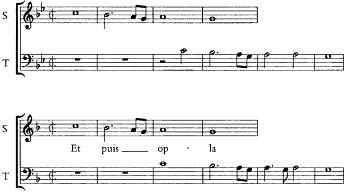
EXAMPLE 45B . (i) Lanoy, Missa , Benedictus, mm. 11-16 (superius and contra); (ii) Martini, contra for Cela sans plus , mm. 1-3 (transposed from G)
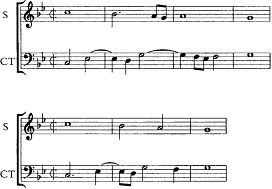
EXAMPLE 46. Motivic comparison of (a) Lanoy, Missa , Benedictus, mm. 1-5; (b) Martini, La martinella (Rome 2856, fol. 138v), mm. 1-5; and (c) Martini, La martinella (Rome 2856, fol. 55v), mm. 1-5

nings of chansons or to the start of the second parts any more than were tenor citations. Thus Richafort quoted in his Requiem both music and text from an interior phrase of Josquin's Faulte d'argent (at "c'est douleur non pareille"), and Du Fay in his Missa Ave regina coelorum quoted the end of his motet.[8] Interestingly, Martini made his own arrangements of Lanoy's chanson. In Rome 2856 Cela sans plus appears with a si placet bass part attributed to Martini. The opening bass counterpoint is also present in the Mass (Ex. 45b). Martini cared enough for this chanson—or its composer—to base an entire Mass on it (as did also Obrecht).
A final motivic detail: The Benedictus and Patrem begin with a melodic turn that resembles closely the opening motive of a few of Martini's Martinella compositions (Ex. 46). It is true that one can find this turn in works of Busnois, Josquin, and others. But given the com-
[8] On the former, see Alejandro E. Planchart, "Parts with Words and without Words: The Evidence for Multiple Texts in Fifteenth-Century Masses," 251; and Paul Kast, "Jean Richafort," cols. 439-43.
pelling similarities already noted and Martini's penchant for this motive, the prominent use of this particular figure as an opening motive further points to Martini as the composer whose style exerted a formative influence over this three-voice Missa . Indeed, were it not for the Speciálník attribution, the many passages related to Martini's chansons would suggest that these movements constitute the tail end of a Mass by Martini, perhaps another Missa La Martinella .[9]
Even if Martini was not the composer, he could not have been far away when it was composed. Just as Martini's influence on the creation of this Mass may be deduced from the many stylistic similarities, so too is his probable connection with it after its composition, indicated by the presence of the Mass in the first fascicles of SPB80, which contains the very repertoire that Martini is presumed to have brought to Rome from Ferrara in 1473.[10] In later years Martini and Lanoy evidently knew each other well. Lanoy was in Ferrara in March 1491. That is when illness delayed his trip from Ferrara to the Mantuan court of Isabella d'Este; by mid-October he had left Mantua without permission in the company of a singer named Alexander. Indeed, on 1 October both Lanoy and Alexander Agricola had joined the choir at the Annunziata in Florence, Karolus as a singer of the San Giovanni chapel. "Launoy" settled in Florence and married the Florentine sister-in-law of Heinrich Isaac. Earlier Martini and Lanoy may have met in Milan. "Launoy" is listed among those departing from Milan in February 1477. The length of his service in Milan cannot be determined because no other references to him there are known.[11] But these encounters are too late for Martini to have had possession of this work by early 1473. What little is known about the two musicians before this does not place them in close proximity: In 1472 Lanoy served as a
[9] There is a three-voice Mass by Martini in Ver759, the Missa In Feuers Hitz on fols. 15v-20 (J. Peter Burkholder, "Johannes Martini and the Imitation Mass of the Late Fifteenth Century," 485-86).
[10] See chapter 4, pp. 97-98.
[11] See Prizer, Courtly Pastimes: The Frottole of Marchetto Cara , 6-7, 10-11; Frank D'Accone, "The Singers of San Giovanni in Florence during the Fifteenth Century," 344; Lowinsky, "Ascanio Sforza's Life: A Key to Josquin's Biography and an Aid to the Chronology of His Works," 40-41; and the note and bibliography in Howard M. Brown, A Florentine Chansonnier from the Time of Lorenzo the Magnificent: Florence, Biblioteca Nazionale Centrale MS Banco Rari 229 , text vol., p. 50, nn. 54 and 55.
choirboy under Basiron at Bourges, and Martini is presumed to have worked in Constance by December 1471.[12]
Missa Au Chant De L'alouete, SPB80, Folios IV-9
The first Mass in SPB80 illustrates well the danger of basing an argument for any composer on criteria that do not include motivic and contrapuntal style. On a purely formal level this Mass shows the influence of Faugues.[13] Entire sections of the Mass return not once but several times. As in Faugues's SPB80 Missa and his Masses on L'homme armé, La basse danse , and Pour l'amour d'une , this Mass repeats the music of the second Kyrie for the Osanna (which itself repeats). And like Faugues's Missa L'homme armé this Mass derives another movement from the same music, in this case the Agnus III. Moreover, as in the Missa La basse danse , there is a link between the Confiteor and the Cum Sancto, the ending sections of the Credo and Gloria. While Faugues repeats all the music, the composer of the Missa Au chant has a nearly literal repeat of the first sixteen breves. Both of these sections are for four voices. In reduced scorings the same music also returns at the beginning of Pleni (three voices for six breves) and at the Credo text "Et unam sanctam" (two voices for twelve breves—the two voices, contra and superius, switch their usual parts).
But the counterpoint, the rhythmic treatment of motives, and the scoring have no relation to what can be expected of Faugues. Whereas Faugues, like Du Fay (and in a different way Busnois), commonly be-
[12] Paula Higgins, "Tracing the Careers of Late Medieval Composers: The Case of Philippe Basiron of Bourges," 15, shows that while still a choirboy (presumably an older one) Lanoy received two vicariates: at Notre-Dame of Montermoyen on 5 Sept. 1472, and at the monastery of S. Ambroise on 8 Jan. 1474; see also Lewis Lockwood, Music in Renaissance Ferrara, 1400-1505: The Creation of a Musical Center in the Fifteenth Century , 131-32.
[13] Rob Wegman, "Guillaume Faugues and the Anonymous Masses Au chant de l'alouete and Vinnus vina, " 38-42, attributes it to Faugues partly on this basis and partly on similarities of imitative texture; however, he also cautions that if not Faugues, then the most likely composer is Martini (p. 42, n. 46). Adelyn Peck Leverett concurs, concluding that "if the Missa Au chant de l'alouete is not Faugues's own, it is at the very least a close and deliberate emulation of his methods" ("A Paleographical and Repertorial Study of the Manuscript Trento, Castello del Buonconsiglio, 91 (1378)," 199).
EXAMPLE 47. Comparison of counterpoint in (a) Missa Au chant de l'alouete , Et resurrexit, mm. 36-44; and (b) Martini, Missa Or sus , Crucifixus, mm. 7-17
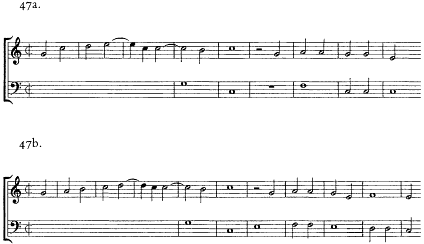
gins the Gloria and Credo with a lengthy duet, the Missa Au chant has these movements start a tre voci , the tenor entering later. In this respect it resembles all Masses by Martini that begin these movements in tempus perfectum . With regard to other features, there are more revealing indications of Martini's authorship. Because there is so little difference between Martini's Mass counterpoint and that in his chansons, fruitful comparisons can be made to each.
Cadences in the Missa Au chant occur with Martini's customary frequency, and from a contrapuntal standpoint they fit into the same patterns that exist in the three of his Masses copied in Milan, the Coda pavon, Ma bouche rit , and Io ne tengo Masses. Of the many possible points of comparison I cite just one. Midway through the Et resurrexit of the Missa Au chant the tenorless trio concludes with the cadence shown in Example 47, a rhythmically square pattern very similar to one Martini used in the Crucifixus of the Missa Or sus .
The Et resurrexit resembles nothing so much as one of Martini's three-voice imitative chansons. At a distance of two breves the contra follows the bass, and the superius the contra, a bottom-to-top progres-
EXAMPLE 48. Motivic comparison of (a) Missa Au chant de l'alouete , Pleni, mm. 24-27; and Martini, Tres doulx regard , mm. 1-4; and (b) Missa Au chant de l'alouete , Pleni, mm. 32-34; and Martini, Tres doulx regard , mm. 9-12
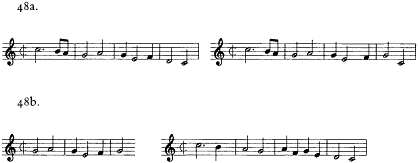
sion that one finds in a half dozen of his chansons, L'espoir mieulx and Il est tel to name two.[14] In the Et resurrexit as in this group of chansons, Martini mixes imitation at the octave with that at the fifth, and he is most strict for the upper two voices. The bass joins at the beginning of a new phrase before going its own accompanimental way. In the Et resurrexit the imitation is strict to the point of being canonic for the first thirty-one breves, at which point there is one breve of free counterpoint as the contra and superius realign to replace imitation at the unison with imitation at the fifth above. In terms of its rhythm, this section, like much of the Mass, rarely departs from the tactus, certainly as compared to Faugues or Caron. There is much counterpoint in which all voices move together in semibreves or one voice asserts itself in brief syncopated figures that last for just two or three breves at a time.
Imitative passages in general in the Missa Au chant are identical to those of Martini, at times even to the motive. Example 48a juxtaposes a motive that comes midway through the Pleni with Martini's chanson Tres doulx regard . Variants of this motive are common during this time, occurring in Martini's L'espoir mieulx as well as in works by Du Fay,
[14] The others are Biaulx parle tousjours, De la bonne chiere, Il est tousjours , and Per faire tousjours .
[15] Du Fay, Missa Ave regina coelorum , Agnus II; Faugues, Missa , Agnus II; Touront, Missa Tertii toni , Agnus II; Naples Missa L'homme armé no. 1, Benedictus; Caron, Se doulx penser ; Cornago, Porque mas sin duda creas ; Anon., Puis fortuna m'avis en tal partit (MC, no. 11).
Faugues, Caron, Touront, and Cornago.[15] But of all the instances I have seen, the two in Example 48a are closest in the rhythmic and contrapuntal handling of the motive. In the Pleni and in Tres doulx regard , Martini presents the motive first in two voices, the superius and then the bass. After eight breves the tenor enters for a period of three-voice imitation on a related motive (shown in Ex. 48b).
The Missa Au chant also features a motive that is ubiquitous in Martini's music, the "English" motive discussed earlier with regard to the anonymous Missa on folios 122-29. Sometimes it appears imitatively, as in Example 49a, sometimes not, as in Example 49b. And in compositions with two flats in the signature—as in the chanson Non per la (m. 40)—this motive is present in imitation a step lower. Curiously, Martini often turns to this motive when the superius dips below the contra or tenor voice; to put it the other way around, when a lower voice rises to the top of the contrapuntal texture, it often does so with this motive, as for instance, in each movement of the Missa Au chant . Example 49c compares Martini's setting of "sub Pontio Pilato" in the Missa Au chant and the Missa Or sus, or sus . Occurring either in the tenor or the contra, this motive crosses over the superius here as in the preceding examples.[16]
A notable aspect of Martini's style is his Italianate sensitivity to harmonic effects. In his Masses and many chansons based on C, Martini routinely has a phrase that juxtaposes a root-position


[16] Compare the three-voice imitative version in the Missa Au chant , Pleni, m. 32, the Missa Coda pavon , Pleni, m. 12, and the Missa Ma bouche rit , Et incarnatus, m. 31; and in his three-voice Missa in Ver759, among several instances, see the Patrem at "et propter nostram salutem" and the beginning of the Crucifixus. See also the Magnificat Secundi toni , Deposuit, m. 32; the Missa Io ne tengo , Et in terra, m. 30, and Qui tollis, m. 45; and O di prudenza fonte , m. 21. In the Missa Au chant this figure occurs also in the Et in terra, m. 22, Et resurrexit, m. 98, Sanctus, m. 16, Osanna, m. 5.
[17] This chanson exists uniquely in Paris 2973. See G. Thibault, ed., Chansonnier de Jean de Montchenu (Bibliothèque nationale, Rothschild 2973 [1.5.13] (Paris, 1991), 20, and the commentary by David Fallows on pp. lxxxviii-lxxxix.
EXAMPLE 49. Comparison of counterpoint in Missa Au chant de l'alouete and Masses by Martini
EXAMPLE 49A . (i) Missa Au chant de l'alouete , Patrem, mm. 6-8; (ii) Martini, Missa Io ne tengo , Patrem, mm. 24-27
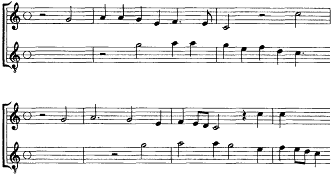
EXAMPLE 49B . (i) Missa Au chant de l'alouete , Sanctus, mm. 16-17; (ii) Martini, Missa Coda pavon , Sanctus, mm. 19-22
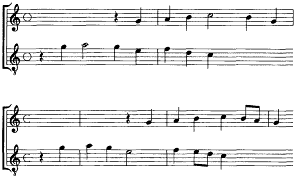
(continued )
pitch and then ascending out of it while the contra moves in contrary motion. A passage from the Osanna of the Missa Au chant de l'alouete matches one from the Osanna of the Missa Coda pavon and the Crucifixus of the Missa Or sus, or sus (Ex. 50). The contra in each leaps back to G, and the bass has an unavoidable melodic tritone as it moves
EXAMPLE 49 (continued )
EXAMPLE 49C . (i) Missa Au chant de l'alouete , Patrem, mm. 37-40; (ii) Martini, Missa Or sus , Crucifixus, mm. 13-21
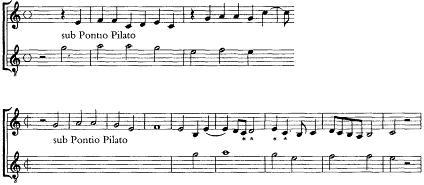
down from



A passage of chordal recitation provides a contrast to counterpoint in the Missa Au chant as occasionally one finds also in Masses by Martini. Harmonic movement comes to a momentary standstill in the Et resurrexit of the Missa Au chant at the text "et vivificantem: qui ex patre filioque procedit" just as it does in the Qui tollis of Martini's Missa Ma bouche rit at "suscipe deprecationem nostram" (Ex. 51). For four breves the voices sustain a single triad, in the manner of falsobordone improvisations of a later period, or, more immediately, like the declamatory Psalm tone settings of Martini that were copied in the latter 1470s into the paired choirbooks ModC.
EXAMPLE 50. Comparison of harmonic movement in (a) Missa Au chant de l'alouete , Osanna, mm. 5-6; (b) Martini, Missa Coda pavon , Osanna, mm. 4-5; and (c) Martini, Missa Or sus , Crucifixus, mm. 9-10
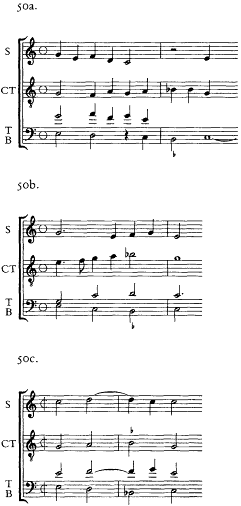
Finally, the choice of chanson for the Mass points strongly to Martini as the composer. Martini (or one of his patrons?) evidently had an uncommon preoccupation with birds. The Missa Au chant de l'alouete would be the third Mass of his to employ a bird motif. He also wrote a Missa Cucu —based not on a chanson but on a repetitive bird call—
EXAMPLE 51. Comparison of harmonic movement in (a) Missa Au chant de l'alouete , Et resurrexit, mm. 49-54; and (b) Martini, Missa Ma bouche rit , Qui tollis, mm. 17-23
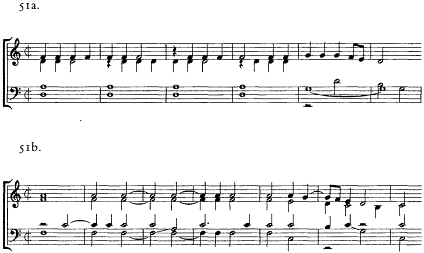
and the Missa Or sus, or sus , the text of which extols the special virtues of a cucu: "Par dessus tousles aultres / Begny soit le coqu!" and later, "Puis le jour de roes nopces / Oyseau suis devenu. / ... je suis un vray coqu."[19]
But what of the Faugues-like repetitions? If musicians at St. Peter's took an unexpected interest in the compositions of one of the most promising young northern composers to find recent employment in Italian courts, Martini shows another sign of being influenced by Faugues in the structural repetitions of the Missa Au chant . Like Faugues, Martini also wrote a Mass on a dance tune (the Missa Coda pavon ), and Faugues is the only composer other than Martini with more than one Mass in ModD, the Mass manuscript compiled in Ferrara in 1481, probably under Martini's supervision.
There is no repetition of the same magnitude in Martini's other Masses. In his Missa Io ne tengo Martini repeats the end of the Gloria at
[19] The chanson survives in Pav362. For the text see Henrietta Schavran, "The Manuscript Pavia, Biblioteca Universitaria, Codice Aldini 362: A Study of Song Tradition in Italy circa 1440-1480," vol. 2, 183-84.
the end of the Credo, but only the last eleven breves and concluding longa. Du Fay rather than Faugues is the potential model for this short repetition. He does the same at the end of the Missa Ave regina coelorum , where the endings of the Gloria and Credo coincide for the last eleven breves of counterpoint, followed by two breves with fermatas and the final longa. The possibility that Martini had a special connection to Du Fay's last Mass is also raised by an intriguing coincidence in the two Italian manuscripts that preserve it. In SPB80 and ModD the compositions that precede the Missa Ave regina coelorum are both Masses by Martini. In ModD it follows the Martini Missa de feria .[20]
SPB80 thus becomes one of a handful of manuscripts from this time that begin with works by Martini. It is no surprise that in Ferrara the manuscript ModD should begin with a Mass by Martini, but that manuscripts copied in Rome, Florence (Flor229), and Trent (Tr91) do as well suggests a broad popularity, a vogue, for the works of Ercole d'Este's composer-in-residence.
[20] On Martini's role in bringing Du Fay's Mass to Italy, and for a discussion of Martini as the prime candidate for the scribe that copied it into Tr91, see Leverett, "A Paleographical and Repertorial Study," 144-67 and 197-99.